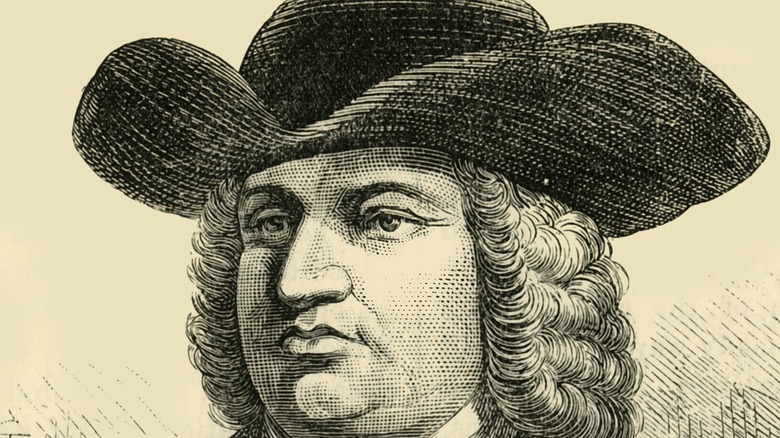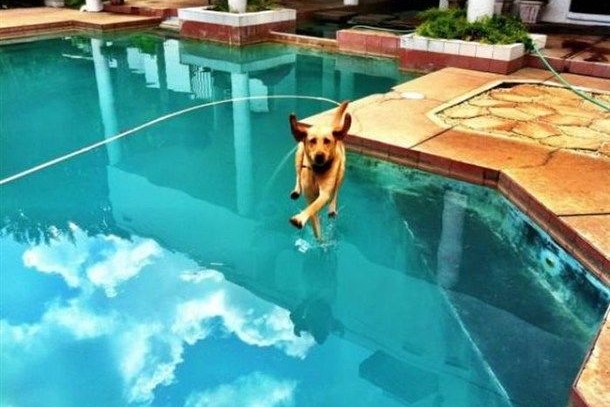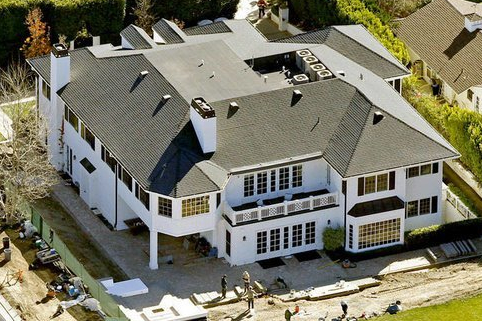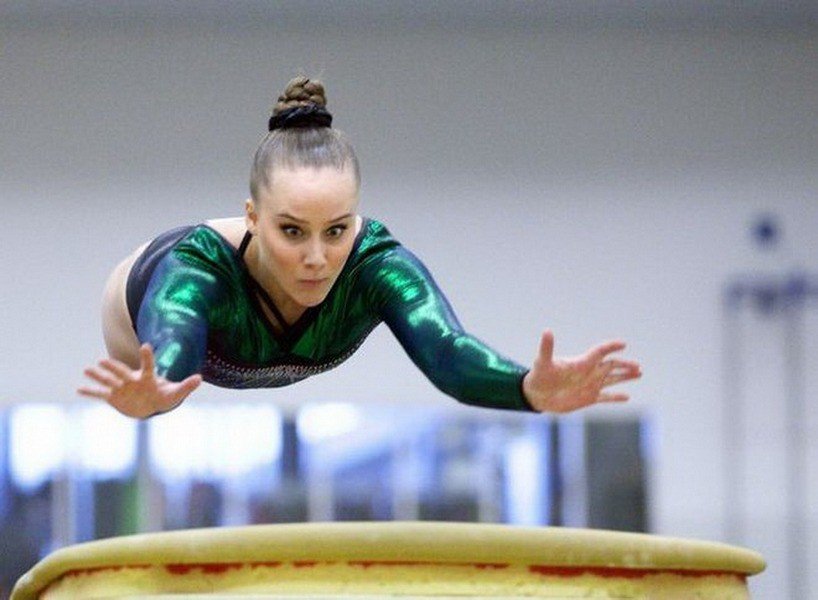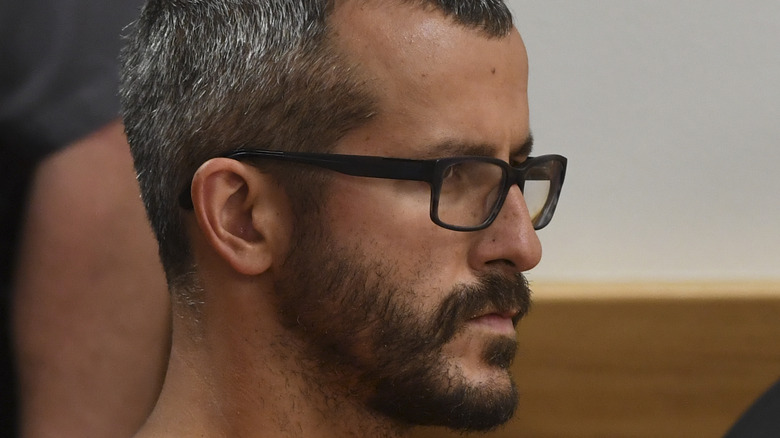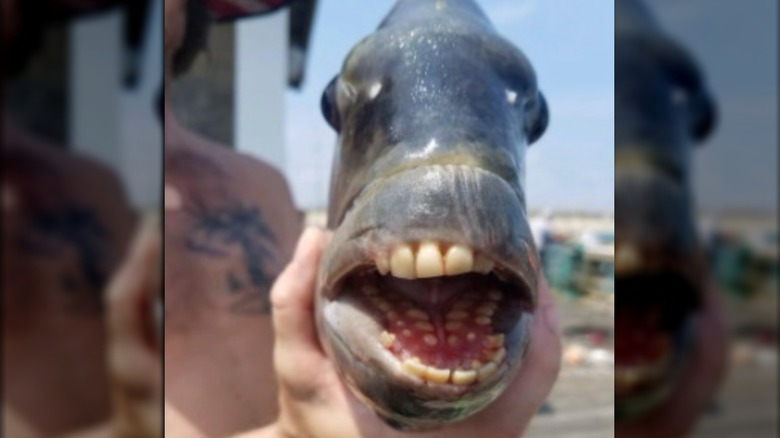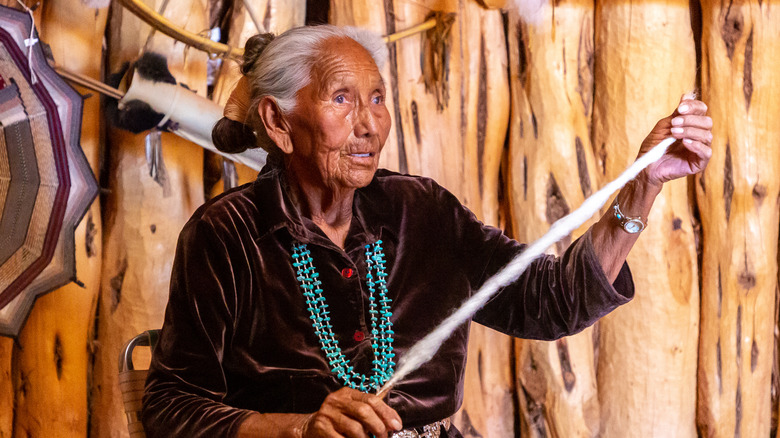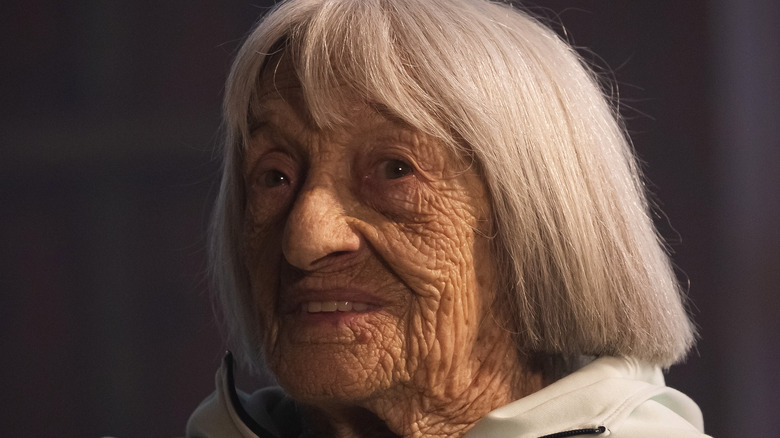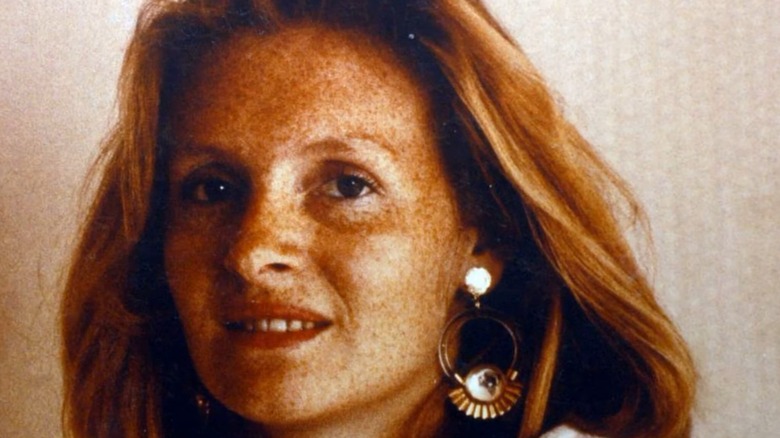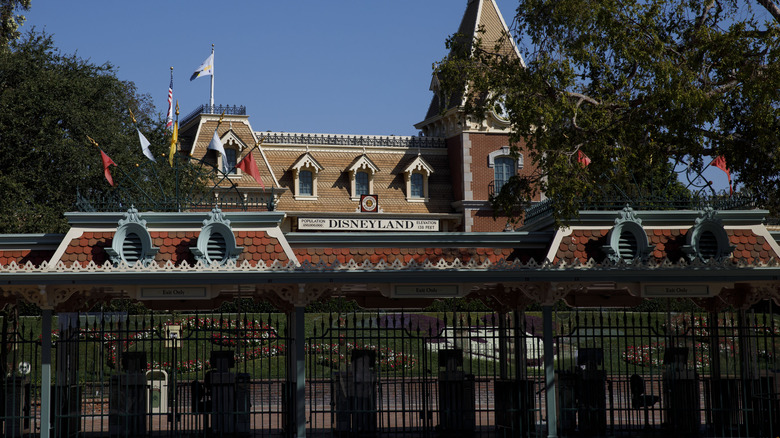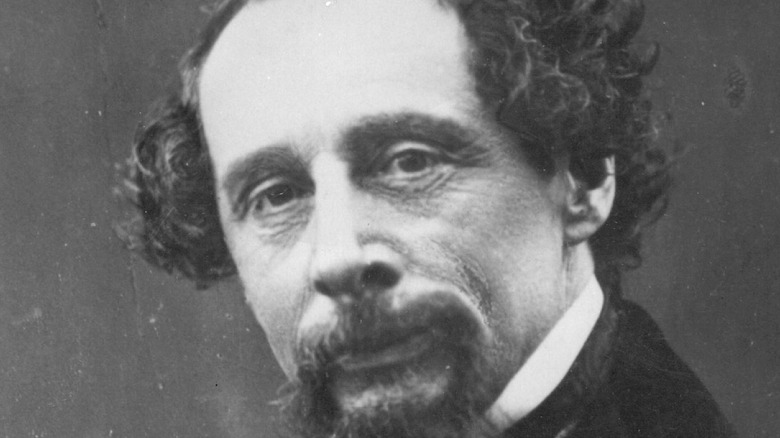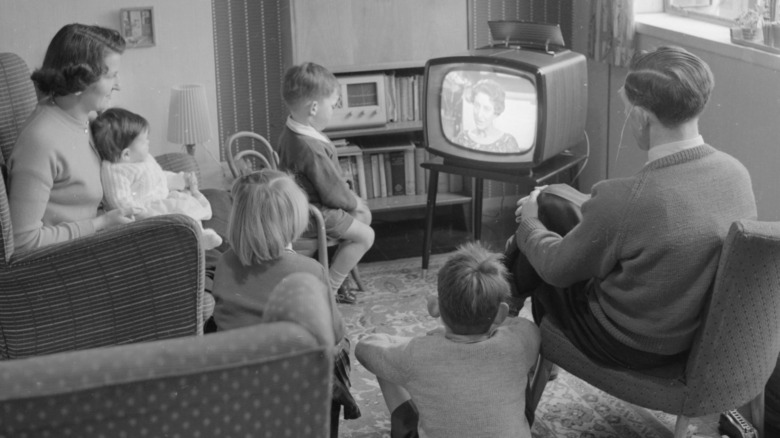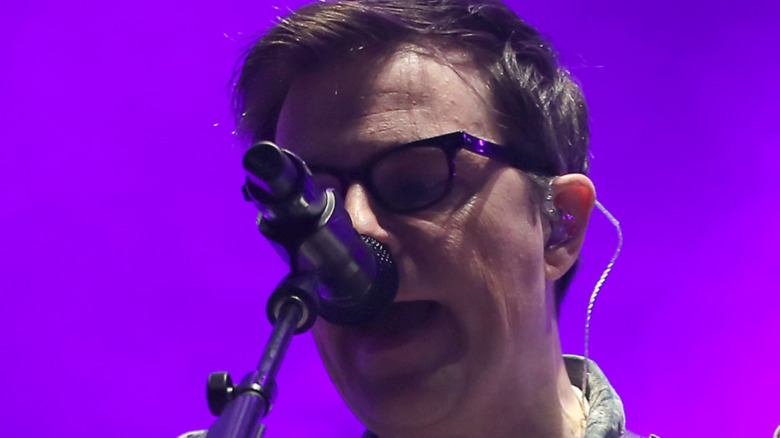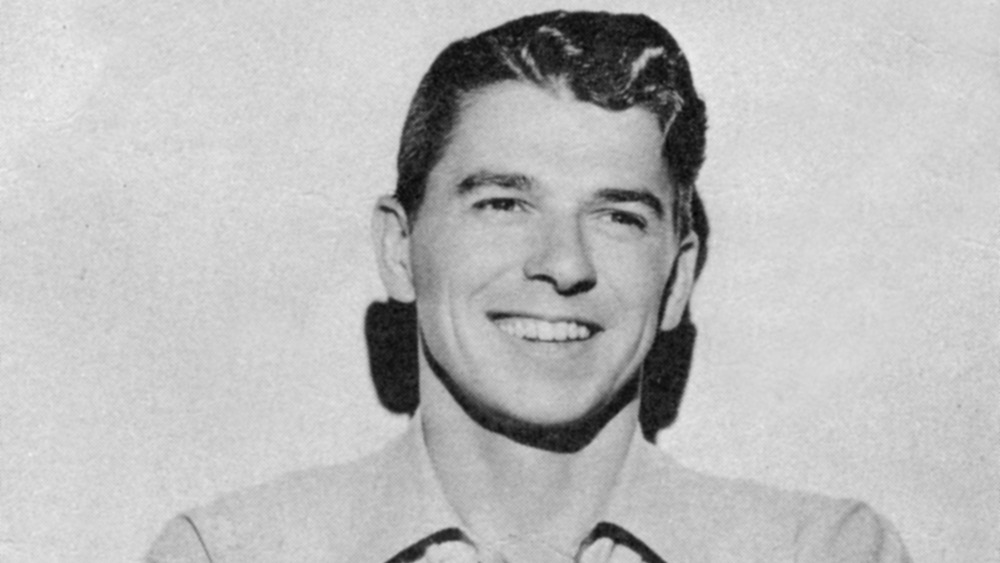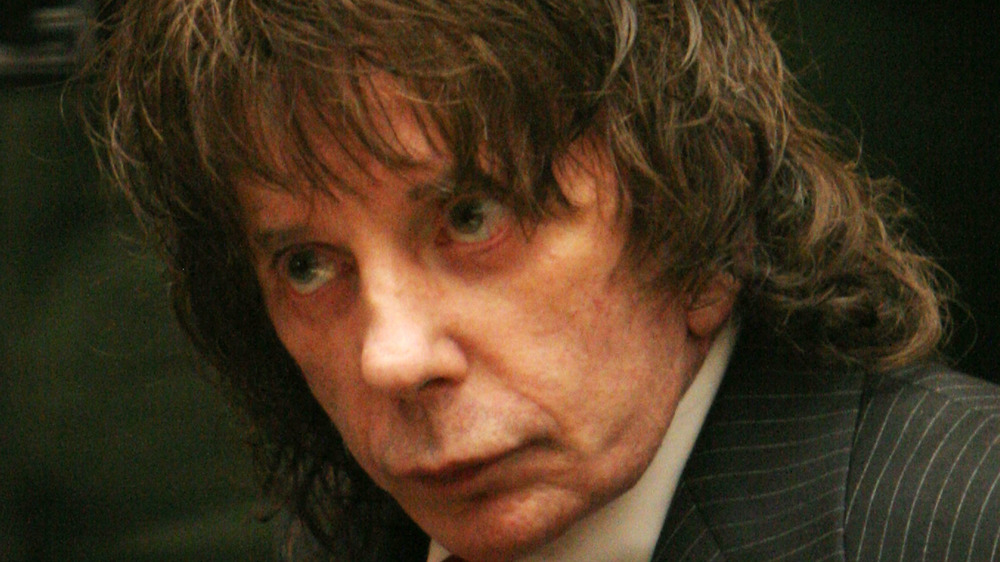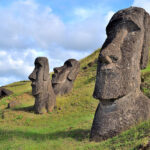
What Archeologists Found on Easter Island Left Them Questioning Everything
Somewhere south in the Pacific Ocean, at the southeasternmost region of the Polynesian Triangle in Oceania, lies a secluded volcanic island, that appears to have mysteriously emerged from the depths of the sea with massive stone statues. The legendary Easter Island Statues. The remote volcanic Island, widely known around the world as Easter Island (Rapa Nui in Polynesian) is part of Chile’s territory and is most famed for its almost 1,000 stone head statues referred to as “Moai” by the early Rapa Nui people who built them.
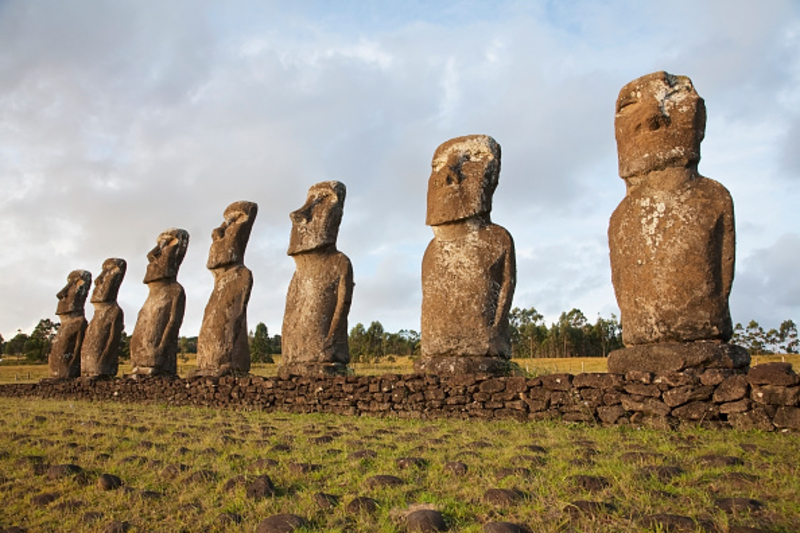
The Island holds plenty of unanswered mysteries and intriguing clues left by an ancient people who once thrived in the distant Pacific island. Its gigantic stone figures have long fascinated explorers, historians and the rest of the civilized world for centuries. Today though, experts reveal that they may have finally cracked one of the island’s most enduring secrets: Who put the statues there and why and how they did it.
The “Cannibal Cave”
The images were captured from the “Cannibal Cave,” portraying what is popularly called as the Tangata Manu or “Bird Man” in literal English translation. The Bird Man signified the winner of a sacred tournament that was held on the island every year. The original settlers of Easter Island would compete with everyone else in finding the first egg of the season.
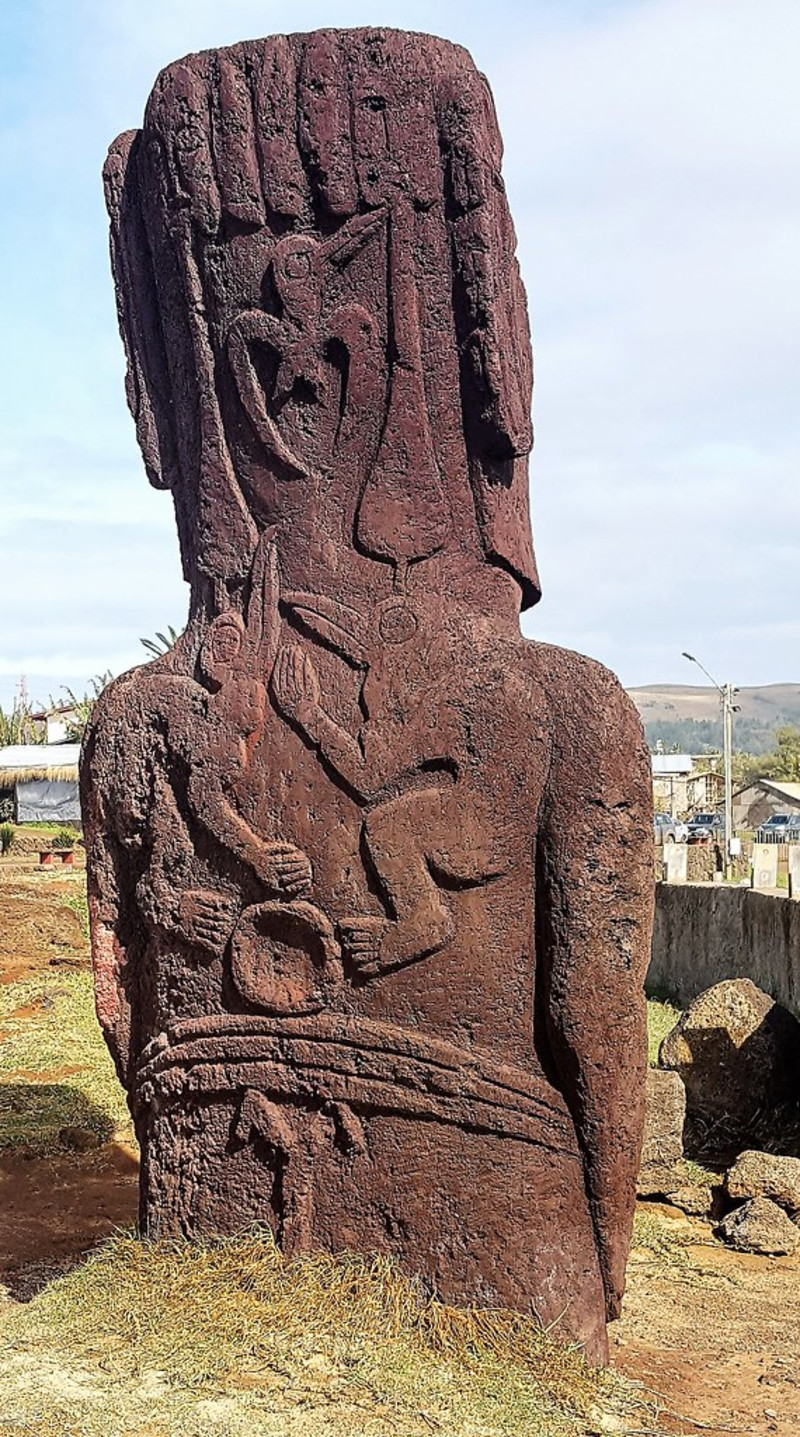
This would normally entail swimming to a nearby island, securing an egg and then swimming back again to Rapa Nui with the egg. The first one to complete the ritual would automatically be welcomed as the Bird Man and the tribal chief of the community for the entire year.
The Missing Link?
Aside from the Bird Man, there were a whole lot more stunning discoveries made on the mysterious island. Underneath one of the nearly thousand massive statues, a team led by Van Tilburg uncovered an especially intriguing relic. The statue featured a crescent symbol engraved in its surface. Based on the findings, researchers theorized that the carvings depicted a canoe or vaka in Rapa Nui.

In addition, the statues that secretly stored the special kind of stone possessed petroglyph writings on its sides. Van Tilburg’s team concluded that the ancient carvings, along with the petroglyphs had a significant link to the people who once built the statues on the island.
How Did They Do it?
Ever since the Easter Island heads were discovered back in the 1700s, no one was able to explain precisely how the Moai could have been built and scattered across the island by ancient people. Many theories have been formulated through the years and each one shared its own unique perspective as to how such a grand endeavor could have been achieved given the various engineering limitations of that particular time.

A popular theory proposed that the massive stone figures would most possibly entail plenty of able hands, ropes, and potentially other tools as well. There are also other theories that propose that its mysterious builders likely have utilized logs to roll the Moai to their designated placements. If the this is correct, then it would mean that the ancient builders of the Moai would have required at least 50 to 100 people to transport the massive structures everywhere on the island amidst countless physical obstacles.
Like Moving Mountains
To simulate the manner in which the ancient builders of the Moai would have carried the giant structures everywhere across the Easter Island, an engineer from the Czech Republic, Pavel Pavel, teamed up with an adventurer from Norway, Thor Heyerdahl, and built their own accurate replica of the Moai statue. The two used a single rope, secured it tightly around the head and then used another one following the same approach on the base of the statue.
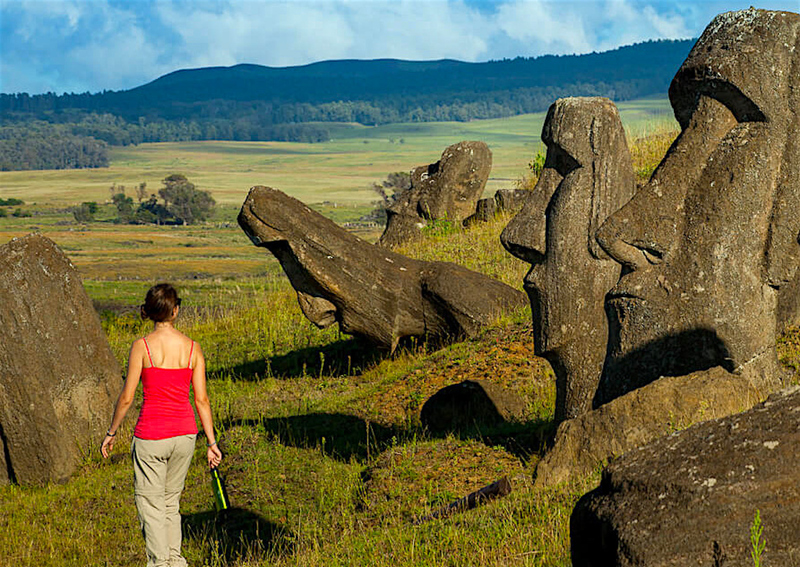
Together with 16 other people, they were able to move the statue albeit in a snail-like pace. But since their pulling created some minor damage on the statue, they opted to conclude the activity in advance. After the event, both made the prediction that it was possible for their team to move the giant statue 330 feet per day. If we did the math, then it would require nearly twenty people 160 days to move one statue for a distance of just one mile!
Resistance
While various contradicting theories exist involving the strange disappearance of the early Easter Islanders, the majority of anthropologists have similar views when it comes to one specific fact. At one particular time during the 18th century, the early inhabitants of the Easter Island began massive riots, in resistance against their tribal leaders.
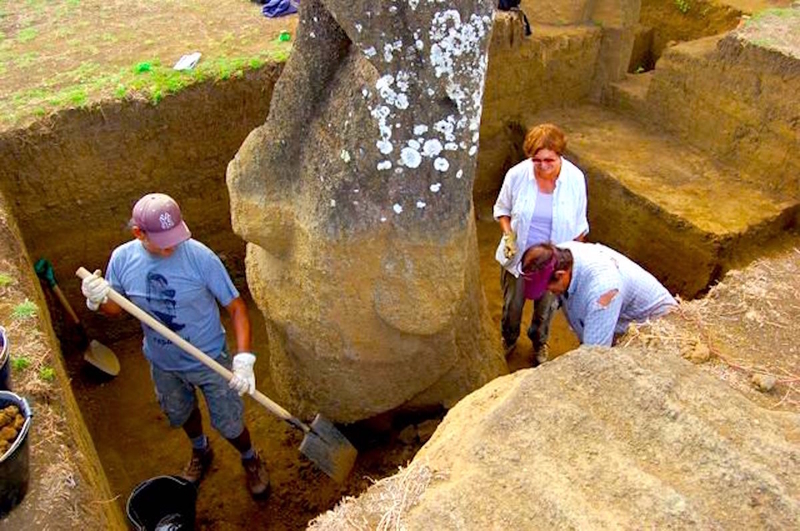
When resources started to dwindle, tensions between various groups grew and eventually explode into violent clashes and actual battles. Because of the large scale unrest that happened during that time, a lot of the Moai statues were destroyed and taken down. As it appears, the majority of the statues were left lying beneath the earth. Obviously, each one of them has been re-elected ever since.
The Norwegian Adventurer
Based on the accounts of Thor Heyerdahl, a famous Norwegian adventurer and ethnographer, Easter Island originally had an ancient road system that its early inhabitants used as a primary means of transportation. The numerous different roads were uncovered together with a number of statues that were uprooted beside them.
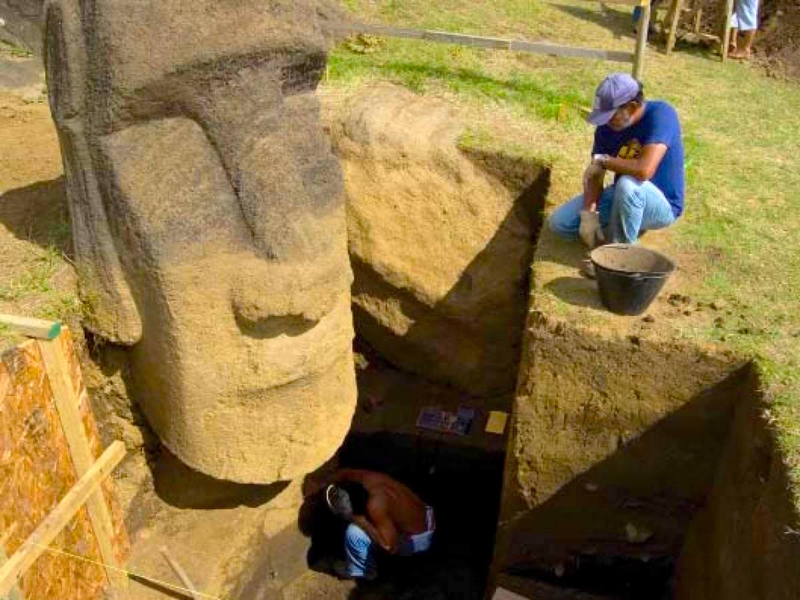
The Norwegian adventurer refuted the British archaeologist Katherine Routledge’s belief that the ancient road networks were in fact used by its original dwellers to cater to religious and ritualistic activities. Regardless of Heyerdahl’s opinions, Routledge’s belief undeniably carries much factual weight. Every ancient road on the island eventually converged to the inactive Rano Raraku volcano, signifying that it served as a primary place of worship for the ancient Islanders.
The Mysterious Heads
The ancient Easter Island stone heads, called the Moai, have long been shrouded with mystery and intrigue. But Easter Island is more than just about its captivating statues. It holds a rich history and enigmatic past that has paved the way to a distinct people and culture. The natives of the island dwelled on one of the most remote communities all over the world and left with them a significant legacy and heritage to their descendants.

And unfortunately, the original islanders also left the world with more unanswered questions than answers. There’s a lot to be told on how these ancient people thrived on the island and managed to erect such massive statues from the ground. Archaeologists had difficulty explaining their exact origins and the reasons as to why the ancient islanders stopped building them. It’s a pacific wonder that’s truly covered in mystery. But perhaps what’s even more puzzling is the location of the island itself…
The Unknown Connections
But it’s not just the island’s gigantic head statues and unexplained road networks that have been shrouded in mystery. Archaeologists and researchers were also puzzled on the kind of writing system that the early inhabitants of Easter Island would have possibly used during their time.
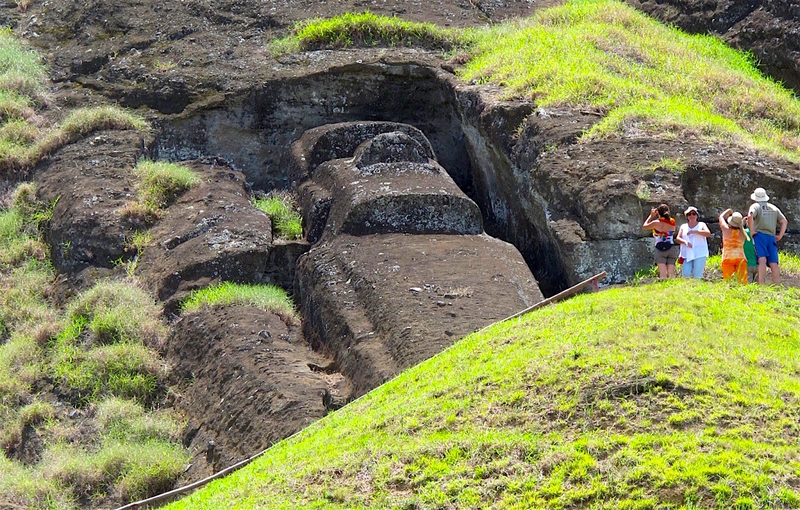
For Robert M. Schoch, an American associate professor of Natural Sciences at the College of General Studies, Boston University, he believes that the tablets with calligraphic writings could date as far back as 10,000 years older than they originally thought. If this were true, then Easter Island would be a lot more ancient than we have expected it to be. The idea hit Schoch following an exploration at the ancient Turkish ruins of Gobekli Tepe and felt that it was somewhat out of place based on where it is situated. Schoch has the same observation with the Moai and the pillars of Gobekli Tepe.
Playing By Ear
Archaeologists managed to dig up some of the remains of the early dwellers of the Easter Island and it gave them some idea about their potential origins as well. The ancient skulls that they unearthed within the remote island were somewhat out of the ordinary. They appeared long and narrow and also indicated that the people of Rapa Nui may have possessed longer ears than the typical human being.
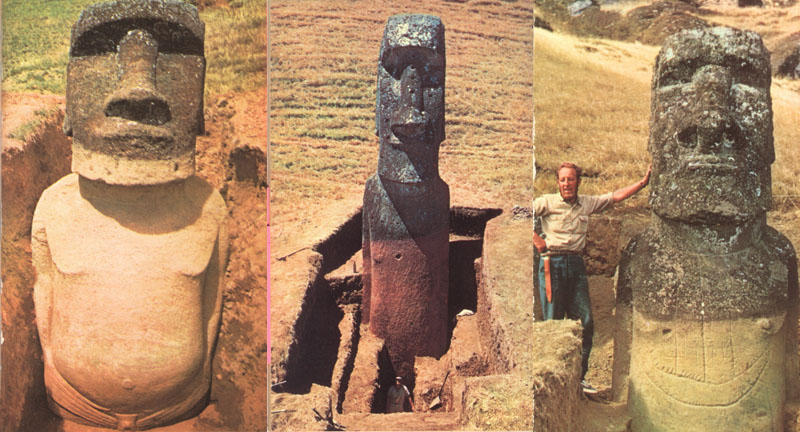
In fact, there is even evidence that indicates a possible battle that occurred on the island between tribes with short ears against another tribe with long ears. The long-eared people appeared to have been ancient Peruvians while the short-eared ones descended from the Polynesian race.
Is it Just a Coincidence?
One major clue that paved the way to an amazing discovery by archaeologists revolved around the height of the Easter Island heads. The tallest Moai statue stands 33-feet from head to base with a reported weight of an incredible 82-tons. That’s nearly equal the combined weight of fifteen full grown, male African Elephants!
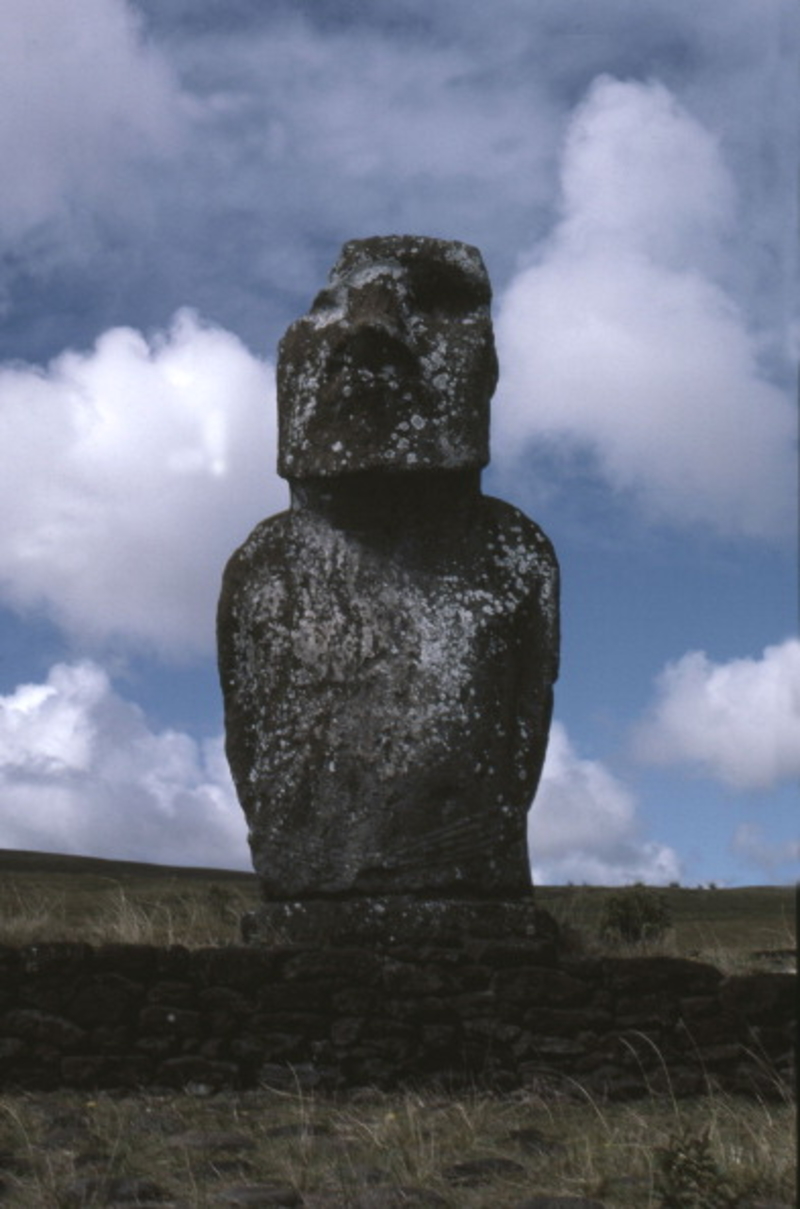
Historically speaking, The Moai were built on the remote, volcanic Island somewhere between 1,100 and 1,500 CE. For reference, CE denotes to the “Common Era” and is sometimes used over AD in historical and archaeological circles. This particular Moai height will be of great help once you find out how the archaeologists managed to stumble on the discovery. Continue reading so you will know what exactly it is that archaeologists unearthed from one of Easter Island’s collection of fabled Moai…
Like a Sore Thumb
The Tukuturi is unlike any other Moai you will find anywhere on the island. First, the unique Moai is fixed on a kneeling position while the rest of the other statues are standing upright. Second, the Tukuturi sports a beard while all the other statues follow cleanly shaven heads. It’s also significantly smaller in size than the typical Moai scattered everywhere on Easter Island. Researchers think that the Tukuturi served as a physical embodiment of an ancient singer
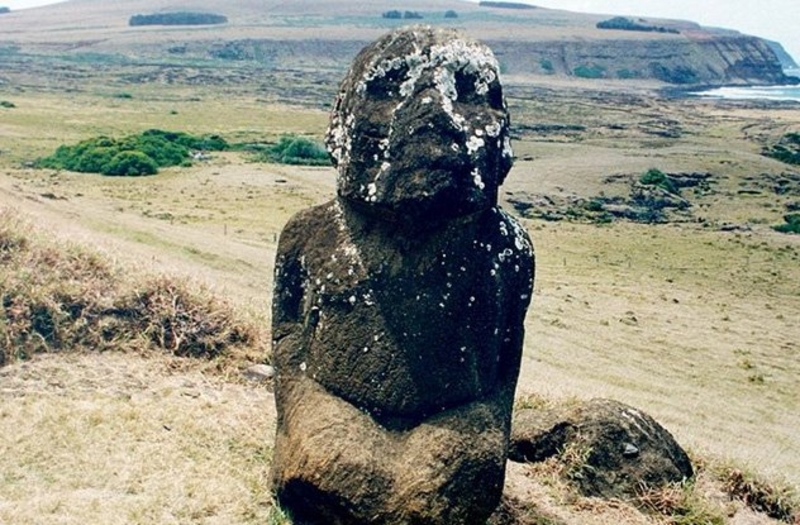
The one of a kind Moai was found in the island’s Rano Raraku quarry, where the majority of the Easter Island’s iconic stone figures were carved. Also, compared to the common, flat-faced Easter Island heads that were largely carved from tuff, which is compressed volcanic ash, Tukuturi was carved from red scoria, which is a more fragile type of volcanic rock. On the nearly one thousand Moai found on the island, only 19 – including Tukuturi – were made from the special material scoria while the rest were carved out of ordinary tuff.
Aliens??
Similar to the rest of the phenomenal ancient structures all over the world, something as mysterious as the Easter Island heads is bound to attract plenty of theories that attempt to explain its true nature and purpose. An entirely left-field theory proposed that the massive statues may have been built by extra-terrestrial beings or aliens. The idea was suggested by Erich von Daniken which he discussed in his book, Chariots of the Gods?: Unsolved Mysteries of the Past.
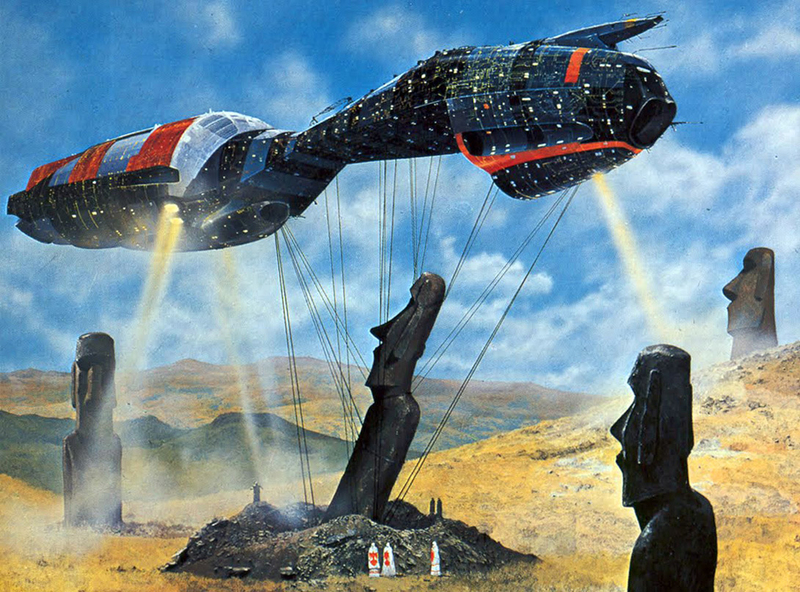
Aside from his proposed alien-based explanations surrounding the Moai, von Daniken also believes that highly-intelligent and advanced beings from outer space also had a hand in the construction of the Egyptian Pyramids and the Nazca line drawings as well. But regardless if you believe this theory or not, one important fact remained and that is that the material used to build the colossal figures didn’t come from Easter Island itself.
A Bizzare Surprise Inside
Formally called the Easter Island Statue Project, a group of archaeologists at UCLA or the University of California, Los Angeles, invested a tremendous amount of time and energy to finally unearth several of Easter Island’s fabled statues and perhaps uncover some of the secrets that may have stayed buried underneath them. At the same time, it would help them better study and preserve the magnificent artifacts. Through this project, the team was able to excavate a number of the heads which ultimately revealed a torso and body that remained concealed beneath the ground all this time.
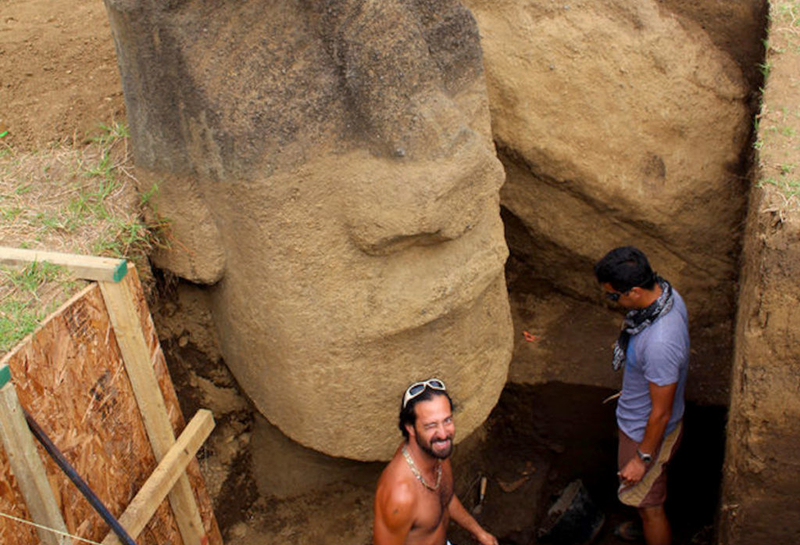
As you can see, the excavations managed to uncover a few remarkable discoveries regarding the Moai that were never known before. This gave researchers vital clues surrounding the statue’s past and the people that went through the effort of erecting them on a remote island somewhere in the vast Pacific Ocean. A considerable amount of red pigments were also discovered within the stone figures. Most likely, the material could have been used by its mysterious builders to paint the Moai.
Ancient Tools
The early Rapa Nui was truly a mysterious people but slowly, researchers learned more and more about them as they continued to study the ancient structures and stumbled into new discoveries. One of the most unique archaeological features that can be attributed to this ancient islanders were the type of tools that they used. Known as Mata, the tools were made from volcanic glass, which the Rapa Nui would then tailor into numerous different designs and sizes.

Majority of the Mata was intentionally crafted to be sharp, so it would be able to cut through tough fibers, carve hardwood and even serve as a weapon. These tools are widely known relics of many Rapa Nui exhibits in various museums all over the world.
Marko Kulju
As one of the only reported heist made on Easter Island and its iconic Moai, a tourist from Finland traveled to Anakena Beach and sliced off an ear from one of the statues. Fortunately, a person saw the plaintiff, Marko Kulju, escaping from the scene of the crime carrying the missing ear from the Moai that he hacked off and reported him to the authorities. The police managed to apprehend Kulju and for his sacrilegious act, was charged with a fine amounting to $17,000 USD.
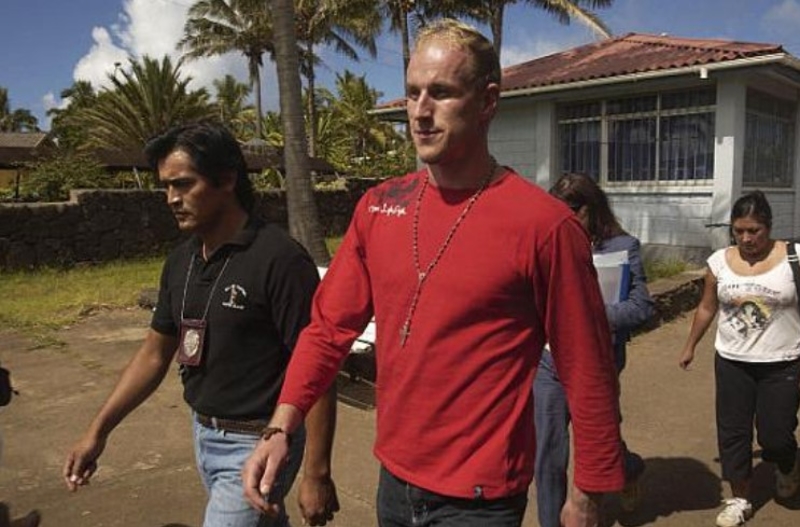
No matter how you view it, the penalty was a slap on the wrist given the fact that Kulju could have potentially faced a sentence of up to seven years in jail for his crime against the people of Easter Island and their ancestors who built the Moai as well. On the positive side, the incident paved the way to tighter security procedures for tourists of the Rapa Nui National park.
The Hoa Hakananai’a
Surprisingly, among the most popular of all the Moai is no longer standing at Easter Island as we speak. Called Hoa Hakananai’a by the Rapa Nui, the iconic statue is currently on exhibit at the British Museum of London. Back in November of 1868, an exhibition team from the British vessel HMS Topaze recovered the stone figure from ‘Orongo, Easter Island.
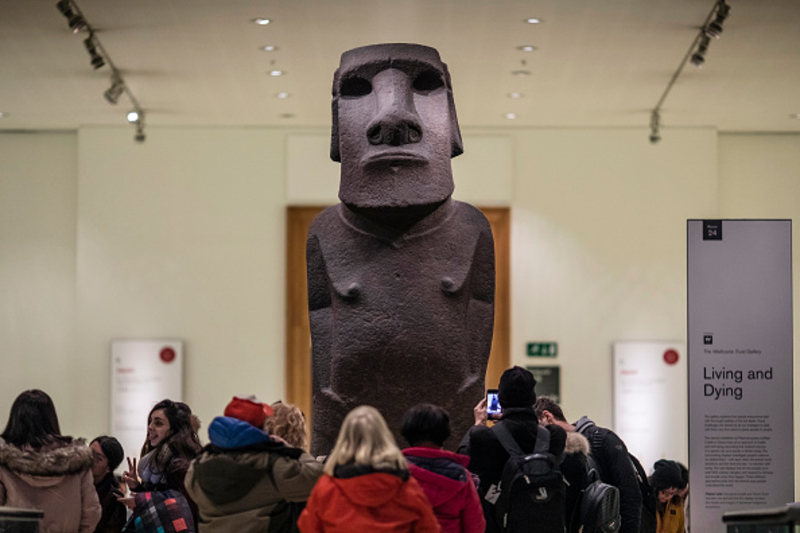
Following an extensive voyage, the Hoa Hakananai’a ultimately arrived in England on the August of 1969. Although it was not as large as the typical colossal Moai found on the island, the Hoa Hakananai’a is generally considered as the model layout for the any and all Moai in Easter Island and considered by all as a work of art.
A Cure for Leprosy
Aside from the several already strange theories that were already mentioned earlier, there is also a bizarre theory involving the Moai which was created by Dr. Anneliese Pontius, a Harvard Medical school psychiatry professor. Pontius theorized that the purpose behind the construction of the Moai was so that the early inhabitants of Easter Island could gain the power to cure leprosy.
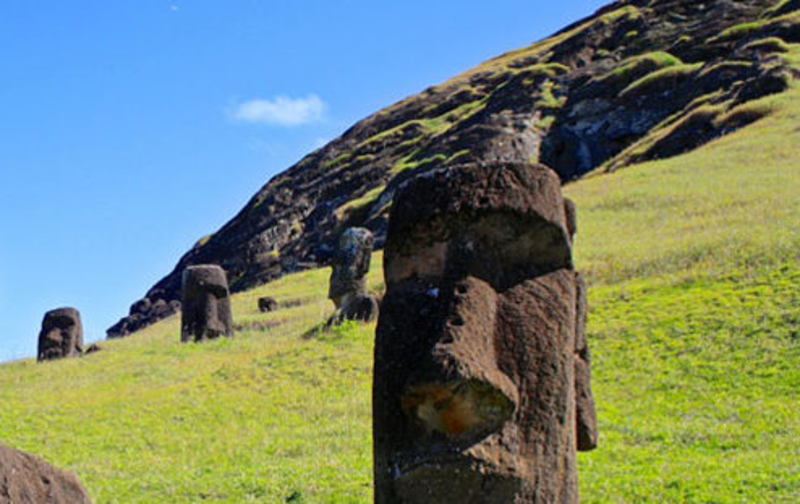
The moment they saw the malformations on the body of leprosy victims, particularly on their faces, hands, fingers, and arms, the natives felt a strong inclination to build the most flawless specimens they could make. They believed that creating such perfect specimens would aid in reversing the physical damage inflicted by leprosy to its victims.
Out with the Old, in With the New
Although the renowned island of the Rapa Nui people is mostly known all over the world for its iconic Moai alongside a rich history that spanned for thousands of years, there are other remarkable things about the remote island that are worthy of praise. For one, Easter Island also has a vibrant modern society that has experienced dramatic changes in a mere lifetime.
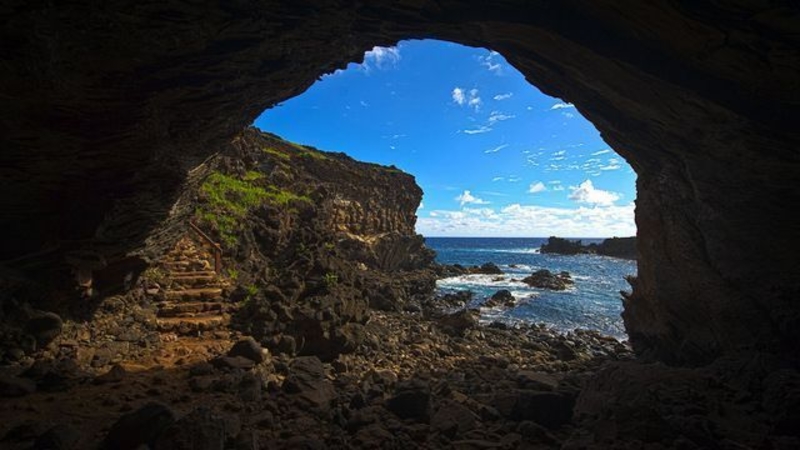
A tour guide on the island once mentioned how his 87-year-old great grandmother grew up in a cave as a child. And for a lot of the inhabitants of Easter Island, the very first time they witnessed an airplane flying above them was perhaps one of the most dramatic moments of their lives.
Survival of the Fittest
The world is filled with people who are willing and ready to offer tourists special insights on the Rapa Nui way of life. This man is a perfect example of such individuals. Moi is employed by a company called Ancestral Tours that shows Easter Island visitors the kind of life that the Rapa Nui people followed in order to survive with the island’s scarce resources, whether it was through its waters or lands.
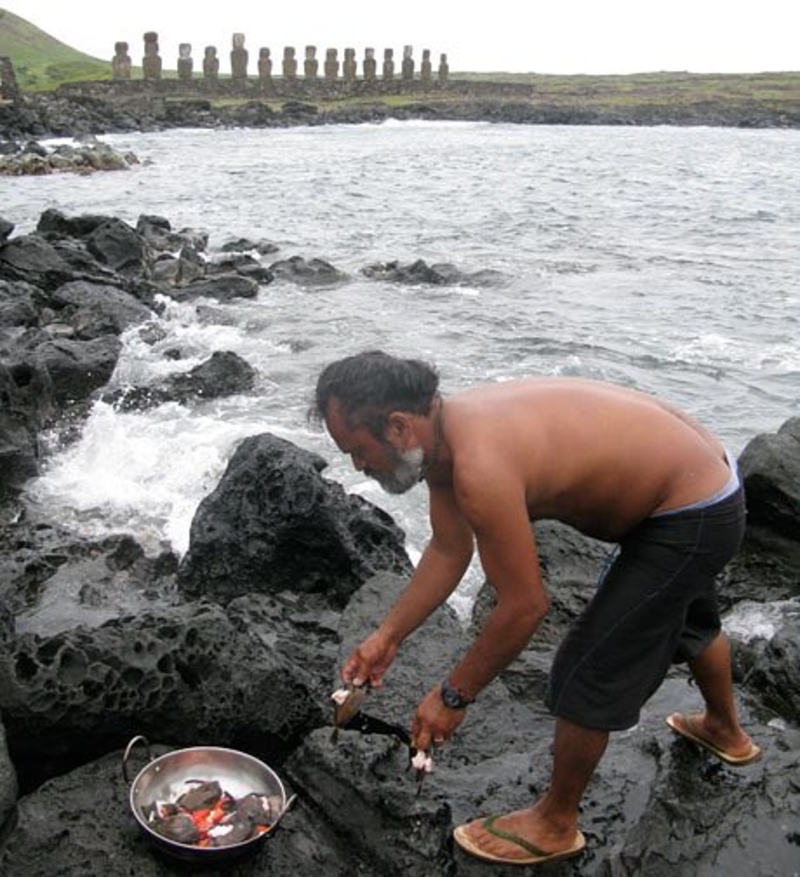
In his water-based exhibitions, Moi guides tourists on a snorkeling adventure at Ovahe Beach. Once they succeeded in catching a fish carried by the waves of the sea, Moi would then prepare it as a meal in front of the tourists and a line of statues who stand by in the background like a squad of soldiers.
The Capital City
These days, Easter Island has more than its fair share of island dwellers who actually do not hail from such parts. Nine out of ten of the island’s populace reside in its capital Hanga Roa which, quite frankly speaking, doesn’t have much going in.
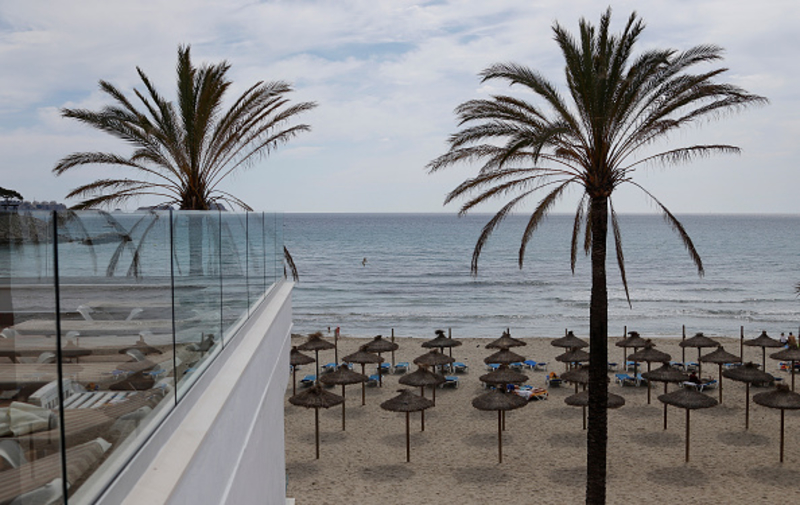
Hanga Roa possesses a pretty undeveloped infrastructure, with just a single bank and a handful of private enterprises. Its government strictly regulates the construction of buildings and structures in the capital because of its strong emphasis on tourism on the island. Nonetheless, there are other various parts of Easter Island that tourists would surely enjoy staying on.
Old School Hospitality
Regardless of the numerous secrets that shrouded the early origins of Easter Island and its people, there is one particular fact that all historians would agree upon even today. During a certain period of the island’s history, its inhabitants experienced serious forest destruction. Historians propose that Easter Islanders of the past burned down a majority of the trees that grew in the island to make room for clear lands as well as build wooden canoes, which served as their primary vessel for seafaring.
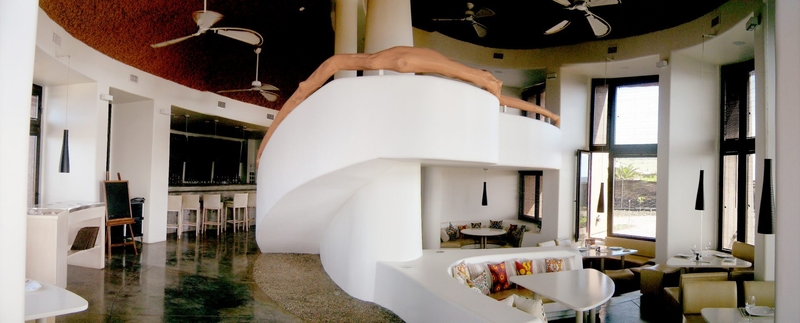
Historians also hypothesized that the ancient islanders crafted special tools to transport the massive Moai. Nevertheless, the Rapa Nui that we see today is dramatically different from what it used to be during the time of its early inhabitation.
Changes Over the Years
Regardless of the numerous secrets that shrouded the early origins of Easter Island and its people, there is one particular fact that all historians would agree upon even today. During a certain period of the island’s history, its inhabitants experienced serious forest destruction. Historians propose that Easter Islanders of the past burned down a majority of the trees that grew in the island to make room for clear lands as well as build wooden canoes, which served as their primary vessel for seafaring.
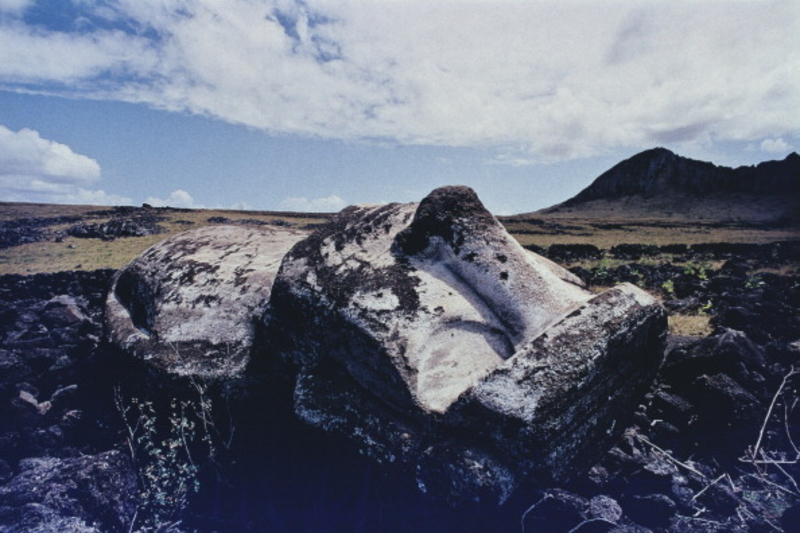
Historians also hypothesized that the ancient islanders crafted special tools to transport the massive Moai. Nevertheless, the Rapa Nui that we see today is dramatically different from what it used to be during the time of its early inhabitation.
Distant Location
As you would have imagined, Easter Island is among the most isolated places in the entire world. The next closest island that is populated, Pitcairn, is located about 1,200 miles west of Easter Island. The nearest major land mass is Chile, which lies 2,300 miles far in the east. Obviously, you’d have to cover thousands of miles of the sea just to get to the remote Easter Island in the Pacific.
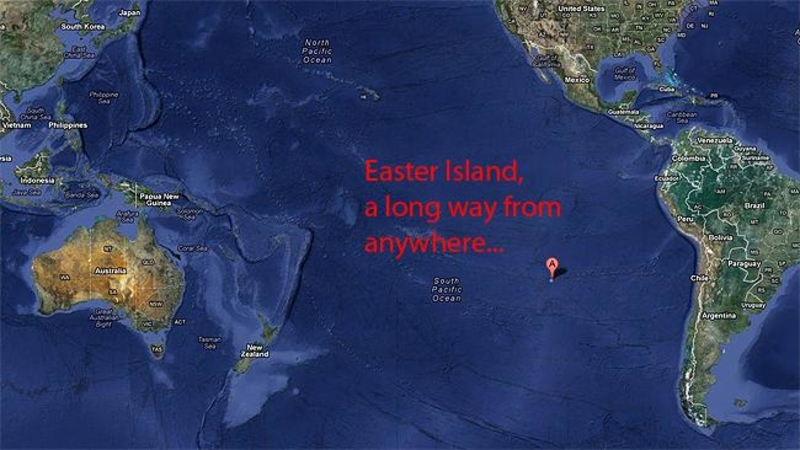
With that being said, the same question still stands: is Easter Island worth such a demanding voyage? Well, the answer will be determined on your level of desire to step foot on the famed island and witness the iconic Moai, up close and personal. Besides that, you will also find an abundance of amazing natural beauty and a rich history everywhere on the island.
Where Did the Name Come From?
The land of the Moai came to be known as Easter Island after it was discovered by a Dutch explorer Jacob Roggeveen during an expedition to find “Davis Land”. Roggeveen was the first ever European to reach the remote volcanic island in the Pacific and called it Paasch-Eyland which meant “Easter Island” in 18th century Dutch. And as it appeared, it was during an Easter Sunday (April 5, 1722), when the Dutch explorer found the island.
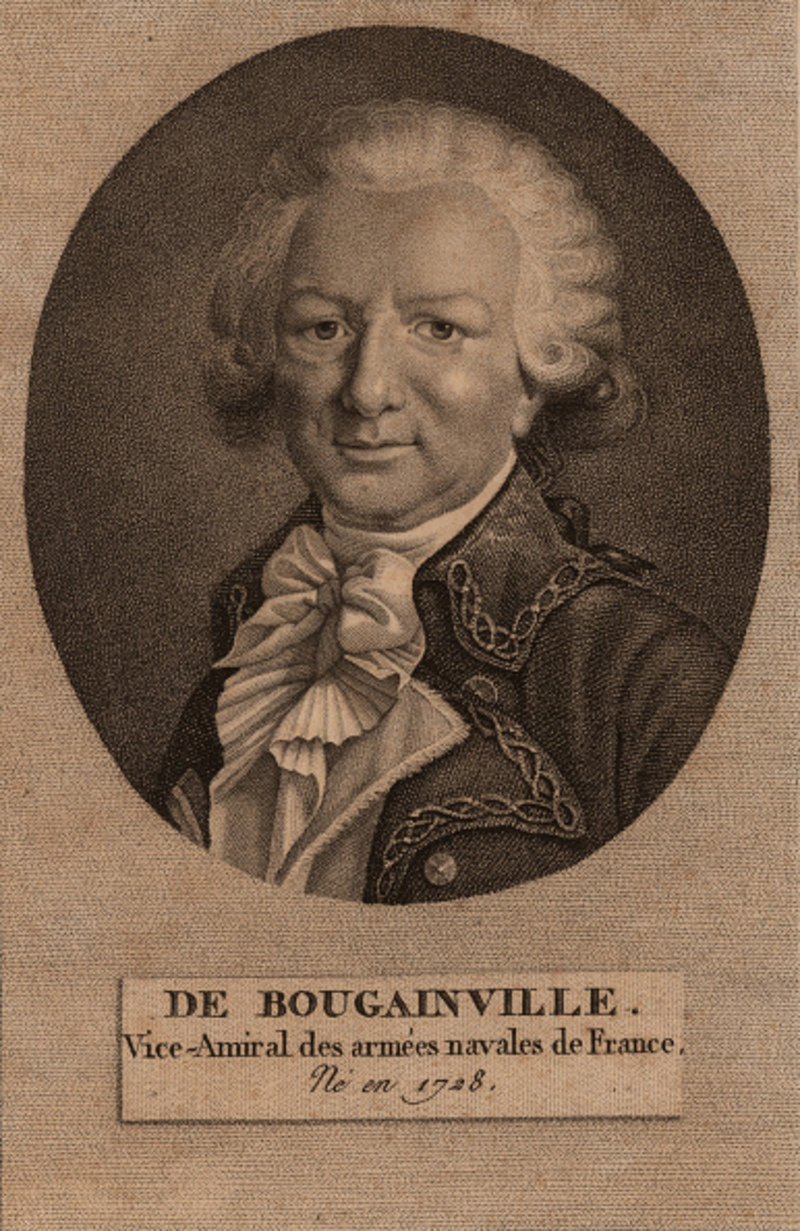
Formally a territory of Chile, the official name of the island is “Isla de Pascua”, which is in Spanish, but at the same time would translate to “Easter Island” in English. It also goes by the name of Rapa Nui, due to its similarity to the Rapa Island of the Bass Islands.
The First Settlers
In contemporary times, a well-known theory about Easter Island suggested that Indians hailing from the coastal regions of South America were the first to populate the secluded island. Following a careful study from renowned archaeologists and linguists though, the theory was eventually discredited by the rest of the academic world.
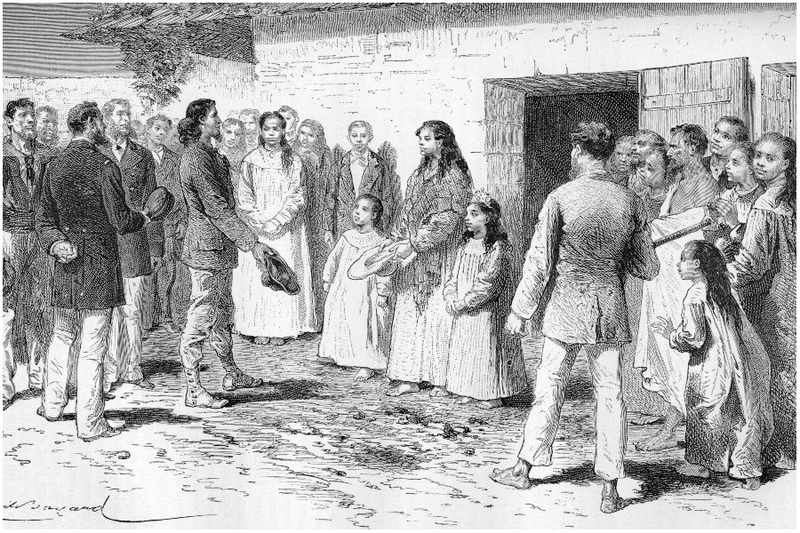
These days, the widely recognized notion is that the original people that discovered Easter Island came from Polynesian ancestry. It’s highly possible that the Islanders came from the Marquesas or the Society Islands which is an archipelago located in the South Pacific Ocean. Historians believe that they arrived in Rapa Nui in as early as 318 AD.
“The Center of the World”
Before the Dutch explorer, Jacob Roggeveen discovered the isolated island in the Pacific and gave it the name that the rest of the world would come to know it for until today, however, Easter Island has had numerous other names way back. The oldest name in record is Te Pito o Te Henua, which directly translates to “The Center of the World” in English.
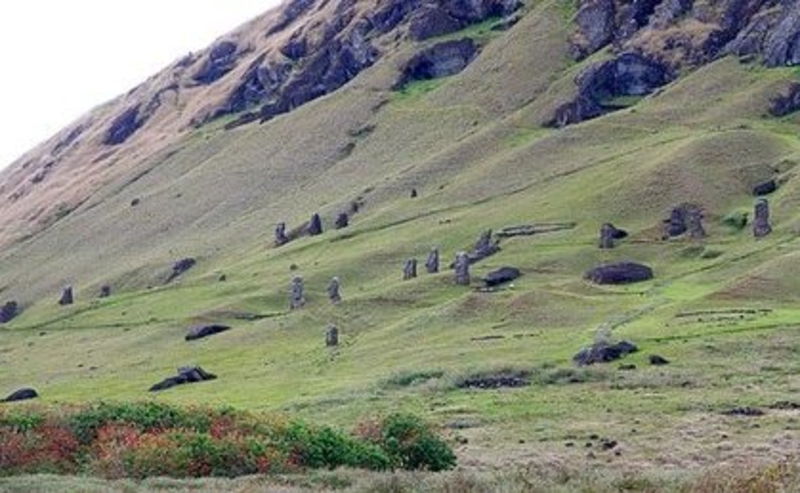
Besides that, settlers of the island also called it Mata-Ki-Te-Rani, which in English means “Eyes Looking at Heaven.” In the end, sailors from Tahiti named the volcanic island Rapa Nui during the 1860s and the rest, as they say, was history.
There Was More Under the Surface
The most recent discovery surrounding the Moai was that the stone heads actually had bodies that were buried deep into the earth. Often times, only their massive heads popped out from the ground which is why nobody would have imagined prior to the discovery that they, in fact, have bodies complete with arms and legs. The discovery also led many to believe that there might be plenty more secrets hidden beneath the ground waiting to be uncovered.
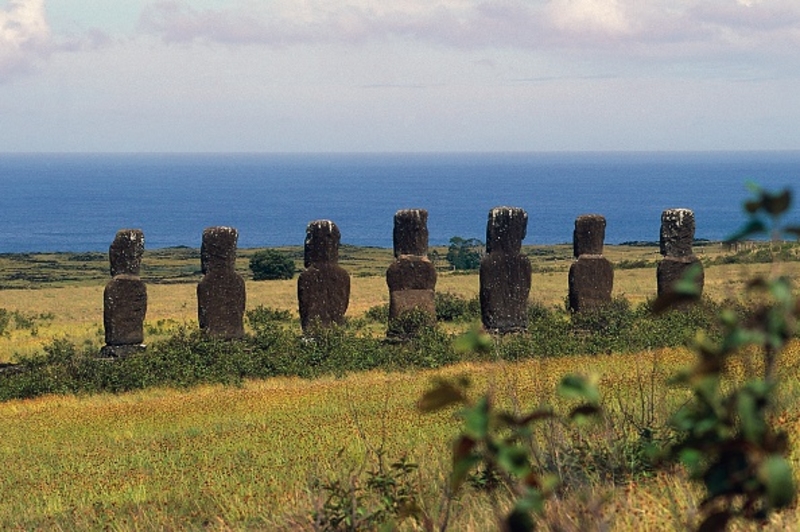
And as it happened, the Moai still had plenty of secrets to share and they were later revealed following a major excavation project led by top archaeologists who discovered that their bodies also featured highly detailed tattoos. If there is one thing that we can learn from this discovery that is there is truth on the saying: “there is more to something than meets the eye.”
The Head Director
The Easter Island Statue Project (EISP) which excavated the Moai bodies was headed by Jo Anne Van Tilburg. Following the determination and hard work of the Van Tilburg team to uncover the hidden secrets of the Moai, she then made an announcement on the company’s website. She revealed, “Our EISP excavations recently exposed the torsos of two 7m tall statues.
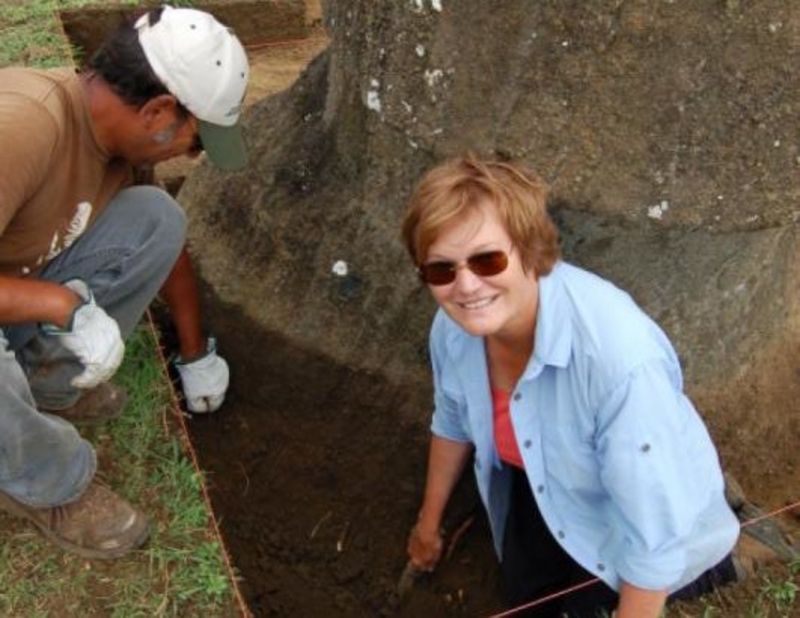
After their groundbreaking discovery, countless travelers and advocates of the mysterious Easter Island across the world were shocked to hear that the island’s long-fabled statues actually had bodies! But perhaps what’s even more important is that we have learned a whole lot about the Rapa Nui and their knowledge of ancient engineering.
Potential Eruption
There are also three dead volcanoes fixed on top of Easter Island and the highest one stands at an astounding 1674 feet. Specifically speaking though, Easter Island is, in principle, a whole massive volcano sitting on a remote region in the Pacific Ocean.
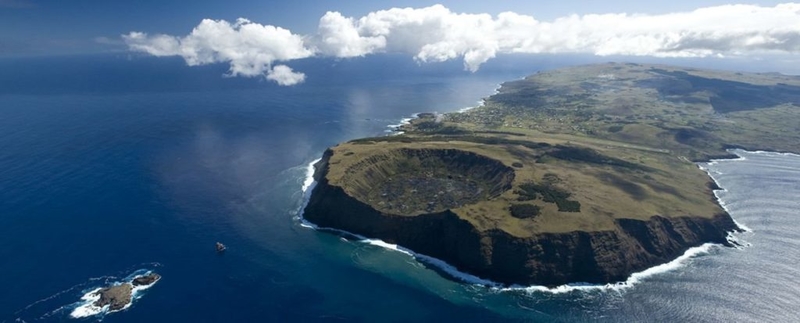
The major volcano in Easter Island is called Rano Kau and it is currently situated inside the UNESCO World Heritage Site of Rapa Nui National Park. Additionally, the Rano Kau volcano is, in fact, the actual site of the ruins of Orongo, the ritualistic community in which the early islanders journeyed to and venerated as a sacred ground of worship.
Rat Infestation
One other theory which could shed light on the mysterious disappearance of the island’s early settlers involved rat infestation. There are historians who support the idea that a surplus of food stocks may have opened up a flood gate of rats that stayed hidden in the canoes of the ancient pioneers of Easter Island.
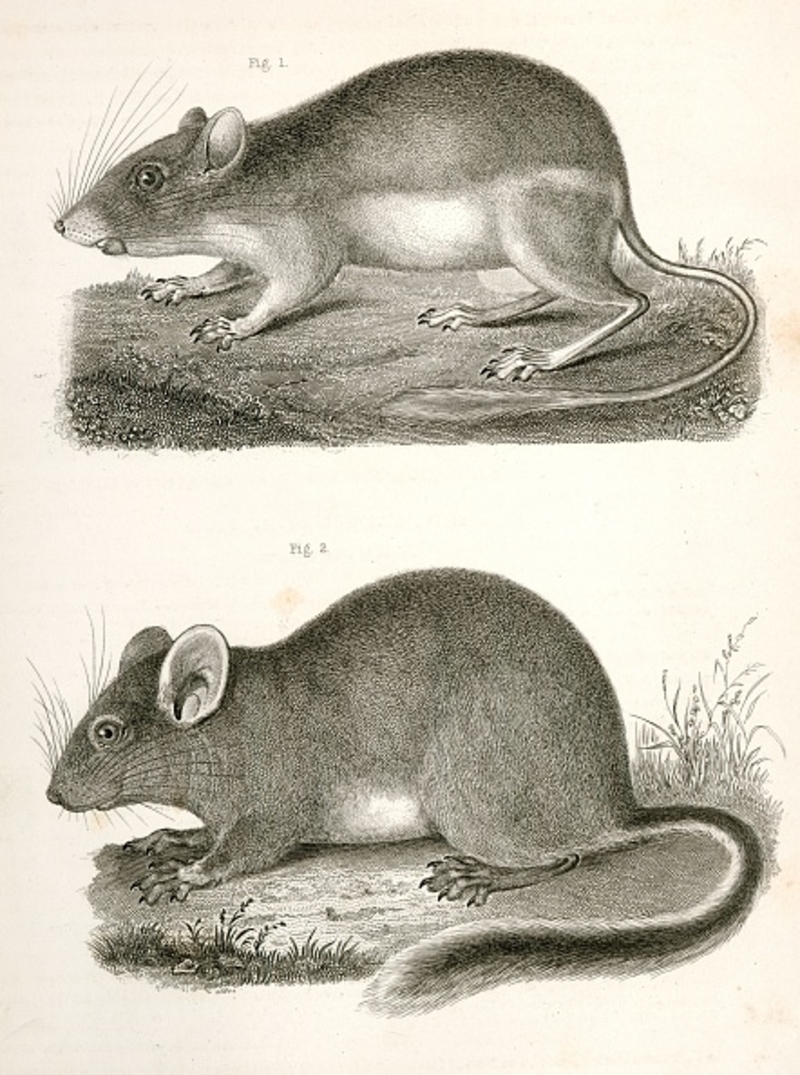
There was a possibility that rodents relentlessly chowed down on their vegetation, stopping them from growing back properly. Regardless of all the havoc that they inflicted though, rats were apparently a main part of the native diet. The notion that the Rapa Nui people put rodents on the menu was supported by hard evidence after archaeologists uncovered rat bones on the island.
What Happened to The Natives?
Although there are numerous different theories surrounding the disappearance of the early Rapa Nui people, it is widely considered today that the ancient islanders became the engineers of their own devastation. That’s what majority of the world’s most prominent researchers believe, that is if we were to talk purely about the living conditions of Easter Island.
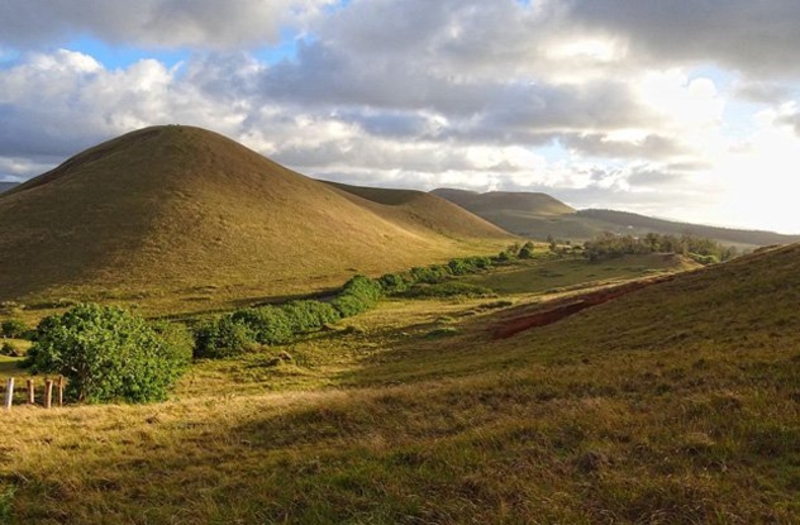
One theory proposed that the settlers shaved the island clean from forest life, with the erroneous belief that trees will naturally grow back fast. In addition, the rapidly increasing population of inhabitants on the island became a major crisis, leaving the place overly crowded and deprived of further space and resources for growth and development.
Who Were the Builders?
In spite of its rich history and the various theories that accompanied it, a conclusive explanation as to who precisely built the colossal Moai statues, how they did it and why, is still up in the air. A widely known theory proposes that the massive stone figures were made by top professional carvers of the ancient Polynesians craft guilds.
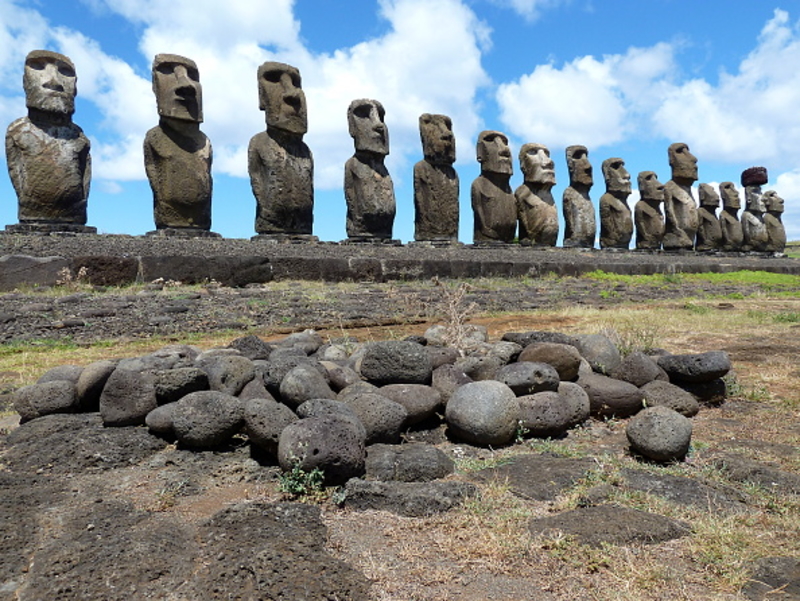
One other theory also proposes that constituents of every tribe joined forces to build the magnificent Moai. This is a logical proposition since the Rano Raraku quarry was known to be divided into distinct regions designated for every tribe that belonged their people.
A Higher Purpose
We have already mentioned a plethora of different theories around the true meaning of the Moai and the more profound significance that they carry but there are plenty more theories that have been thrown throughout the years. A considerable number of archaeologists support the notion that they were built to symbolize power and ruling.
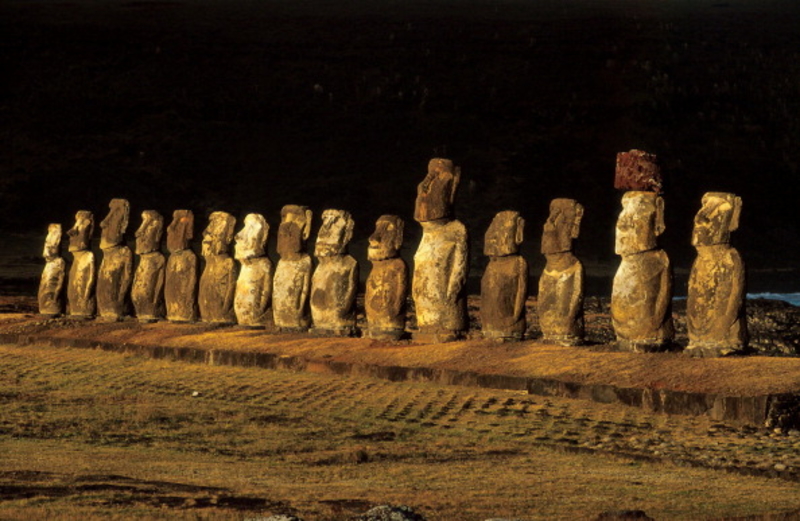
For the people living on Easter Island however, the Moai served a far higher purpose and meaning. The Moai were recognized as physical embodiments of spirits deeply rooted in their beliefs, culture, and identity as a people. There’s also a theory suggesting that the Moa manifested their old ancestors, who continually watch over the island and its people, far across the sea.
The Head Figures
It’s highly likely that you may have first stumbled upon Easter Island and its captivating features during a geography lesson or study. The island that’s hidden far away in some distant part of the Pacific Ocean holds a constellation of massive statues that look like heads.
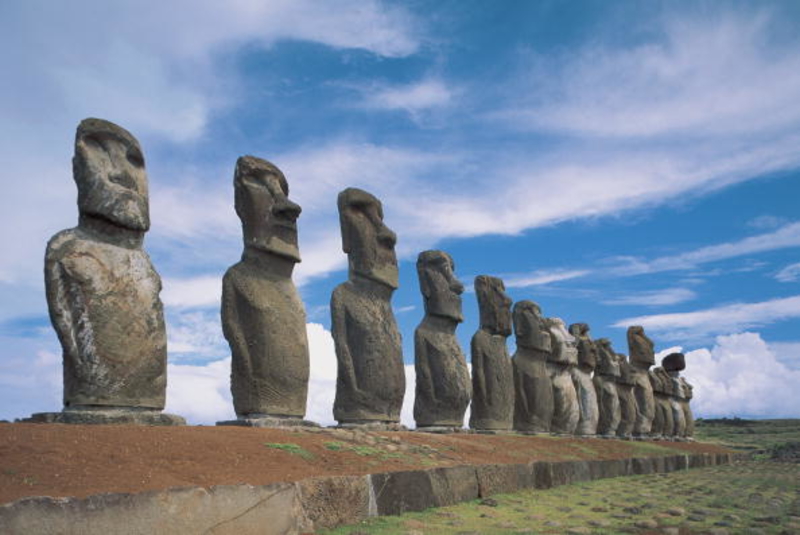
From the Polynesian word meaning “head,” the strange stone figures were appropriately named Moai. And never think for a moment that this image tells the whole story as there are far more stone heads sitting on the island than what is shown in the picture. All in all, there are an astounding 887 Moai scattered across the island. What’s more, there are more to the Moai than just a cluster of heads sitting on a secluded volcanic island in the Pacific.
UNESCO Status
Easter Island is home to the world renowned Rapa Nui National Park which was included in the list of UNESCO’S World Heritage Sites more than two decades past. The National Park’s recognition as a World Heritage Site finally came into fruition thanks heavily to its immense popularity all over the world and the legendary Moai which embellished the volcanic island gem of the Pacific.
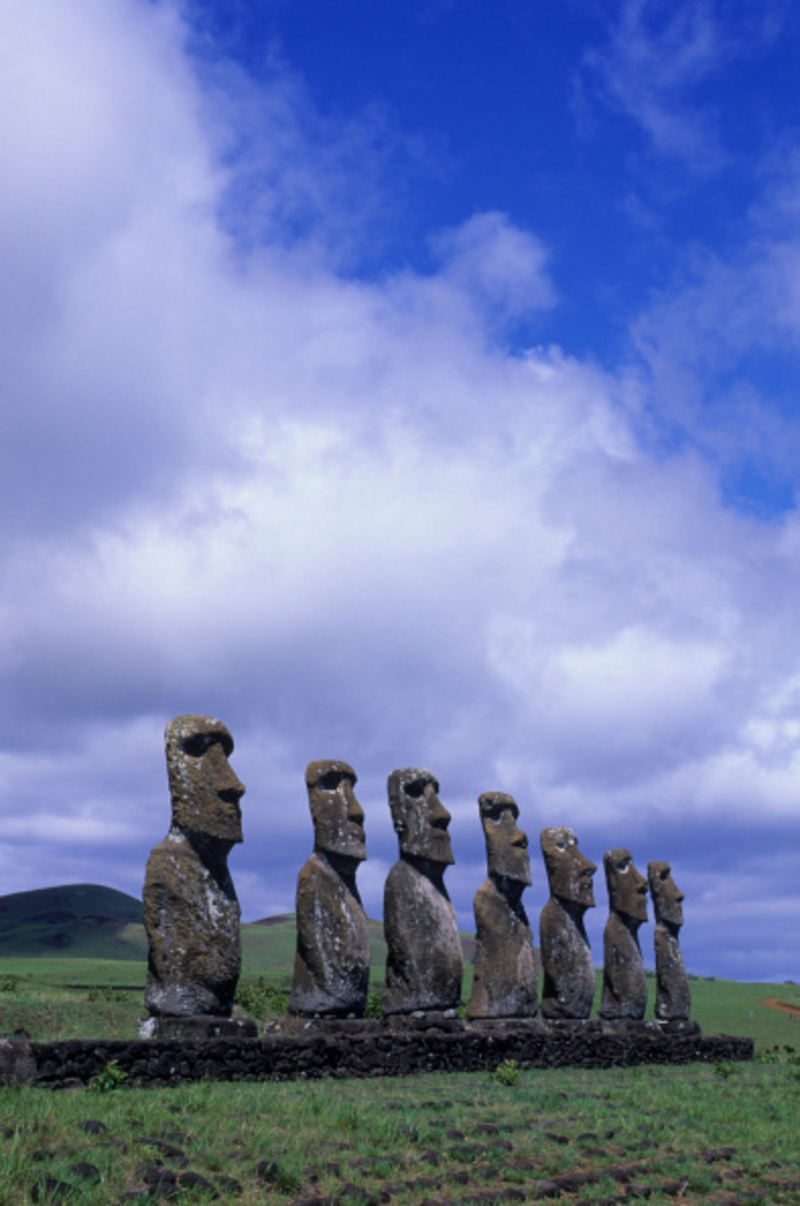
A significantly large chunk of Easter Island has been officially stated as a territory of the Rapa Nui National Park. On March 22, 1996, UNESCO ultimately gave Rapa Nui National Park the prestigious World Heritage status in its criteria of culture.
Long Hair Don’t Care
You might be surprised to learn that the Moai actually sported hats. The headgear, called pukao in Rapa Nui language, apparently signified human hair. Easter Island Natives used to wrap their hair securely around their heads similar to the shape of the ball. It’s the same rationale why tribal chiefs would refuse to shorten their hair because of this common practice.
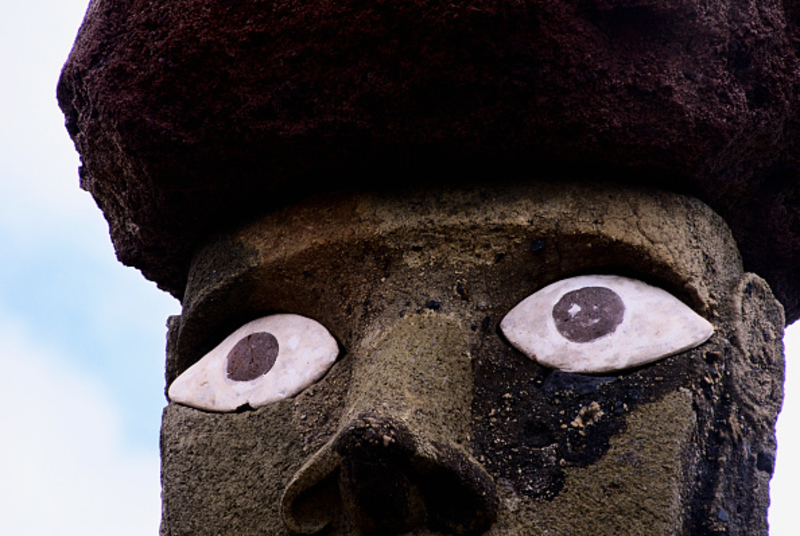
Ancient islanders believed that mystical powers called “mana” were linked to a person’s hair which meant cultivating a long, healthy hair would give you good fortune. Because of this belief, men would carry stones, mount them up against the Moai and then move the pukao above the head.
Spiritual Awakening
In the course of Jacob Roggeveen voyage to Easter Island in 1722, the Dutch explorer shared his thoughts on the Rapa Nui people’s strong affinity toward the spiritual and supernatural. Roggeveen shared, “they relied in case of need on their gods or idols which stand erected all along the seashore in great numbers, before which they fall down and invoke them.”
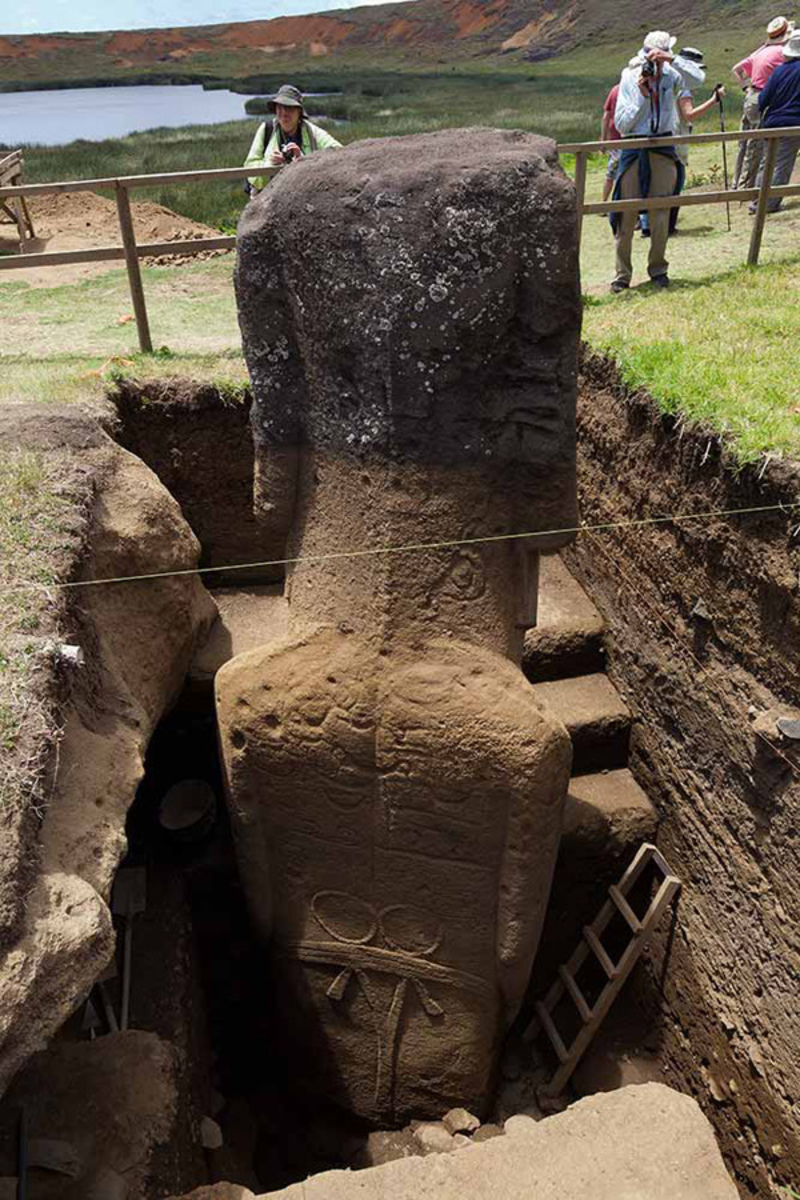
The first European to discover Easter Island further revealed his thoughts, remarking his observations on priests, who demonstrated far greater devotion to the Moa more than anything else. He also noticed that the religious men looked dramatically sincere compared to the typical islander.
Different Statues
One structure that typically gets overshadowed by the grandeur of Easter Island’s famed stone heads is the Mo’ai Kavakava. These ancient crafts were tiny figures made from wood depicting lanky men. The bizarre structures also hail from Easter Island.
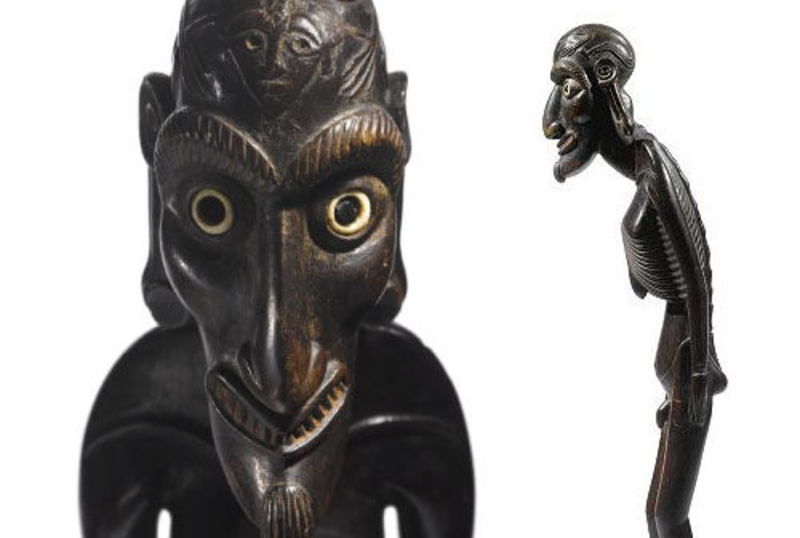
The word Kavakava directly means “ribs” in Rapa Nui, which is logical due to the skinny form of the man portrayed by the wooden figures. Many historians and archaeologists believe that the Mo’ai Kavakava symbolized hungry evil spirits and were worn by priests and other spiritual men when they performed ritualistic dances. These men would carry the emblems around their necks like a necklace in special gatherings and events of the community.
The Legend of Akivi
The sacred grounds of Ahu Akivi plays an especially important role in the rich history of both the island and people of Rapa Nui. Seven identically built Moai erect upright from the ground, aligned straight together side by side, with their heads facing the sunset in the arrival of the Spring Equinox. With the advent of the Autumn Equinox, they would then shift their gaze away from the sunrise.
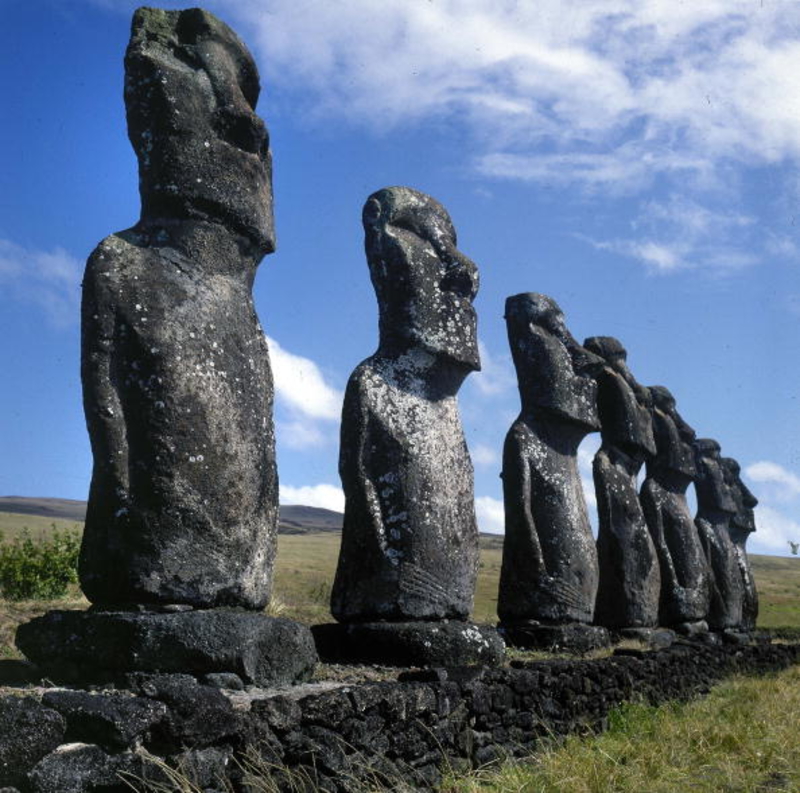
The seven aligned statues symbolize the seven guardians who were visited by the King’s astral form during a dream. The spirit of the King gave the seven protectors direct orders to wait for him and his scouts to come back from their journey over the Pacific Ocean. And wait for an eternity they did in the form of statues…
Misconceptions
The director of the Easter Island Statue Project, Van Tilburg, believed on the importance of debunking misconceptions that surrounded the Moai. Tilburg made a strong point by exclaiming that “the reason people think they are [only] heads is there are about 150 statues buried up to the shoulders on the slope of a volcano, and these are the most famous, most beautiful and most photographed of all the Easter Island statues. This suggested to people who had not seen photos of [other unearthed statues] that they are heads only.”
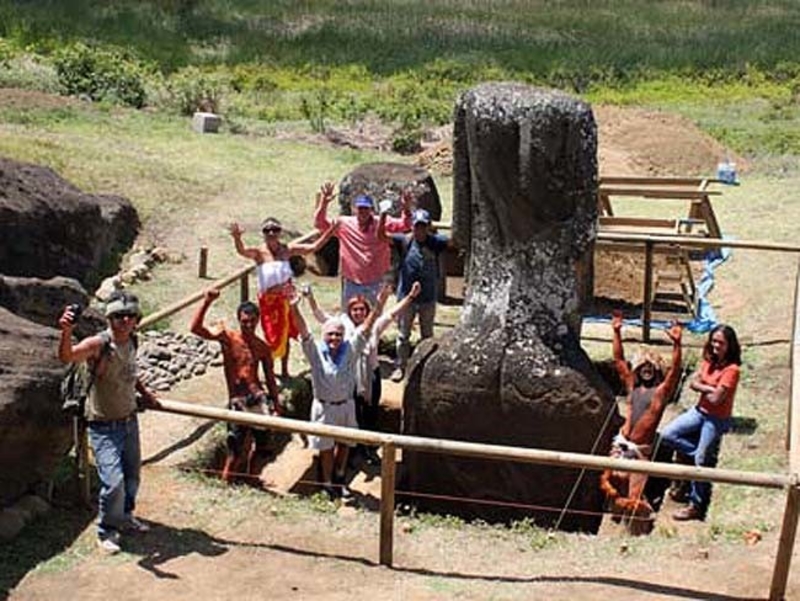
Indeed, if people only take the time to do a bit of study and research on the latest discoveries of the Moai, they would know exactly what Tilburg was talking about. They would also change their perceptions about the Moai; that they are more than just strange heads popping out from the ground and make for good photographs, but living relics left by people who roamed the vast Pacific Ocean long before the time of European explorers. Most importantly, these bizarre stone figures may hold the key into finally unlocking the mysterious past of these once great island people.

Natural Cures That Are Supported by Science
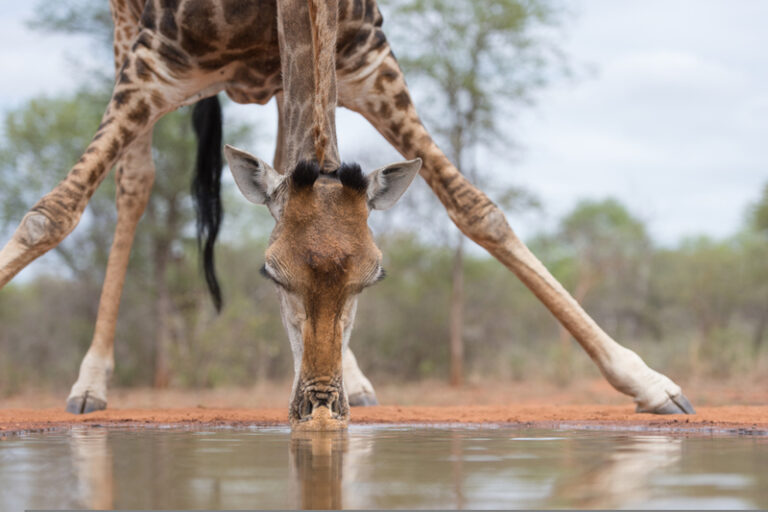
Interesting Facts You Might Not Know About Giraffes
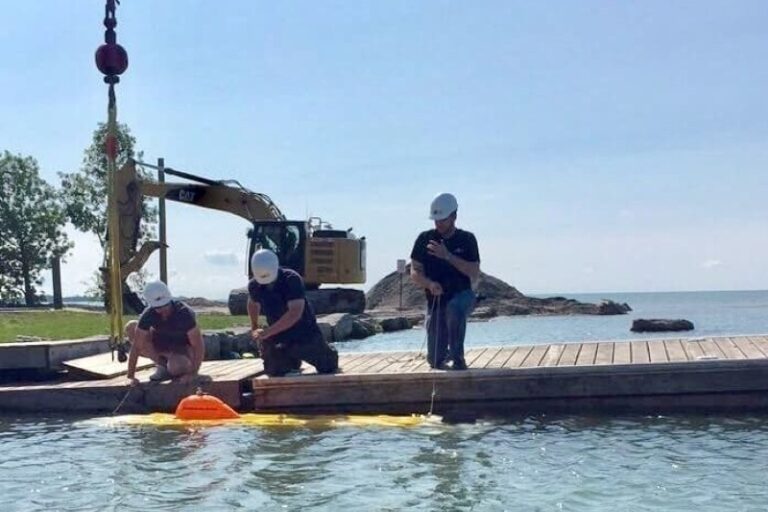
Scientists Investigate Lake Ontario When Submarine Spots Mysterious Object

A New Organ Has Officially Been Discovered In The Human Body
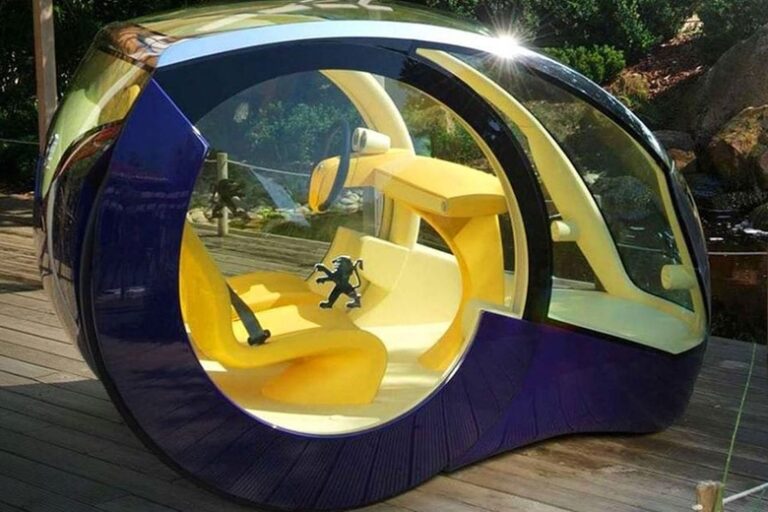
Incredible Concept Cars That Were Never Made
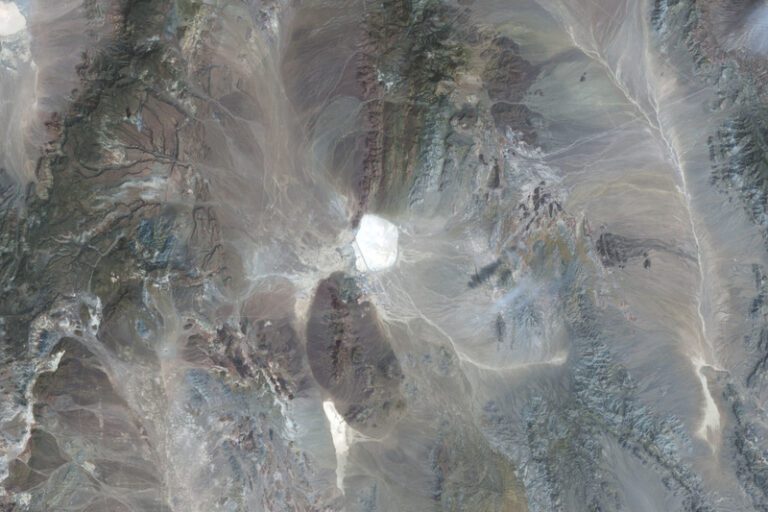
Aliens, Spaceships, and Conspiracy Theories: Area 51 Explained
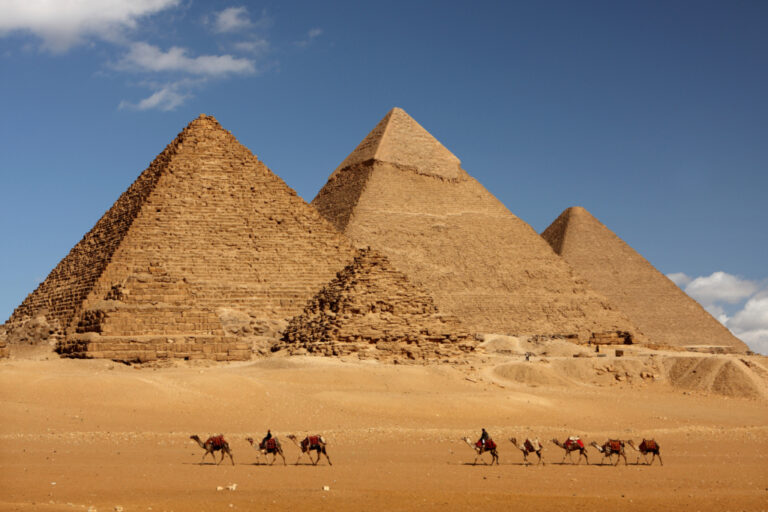
Ancient Egypt’s Most Interesting Discoveries We Know about the Pyramids
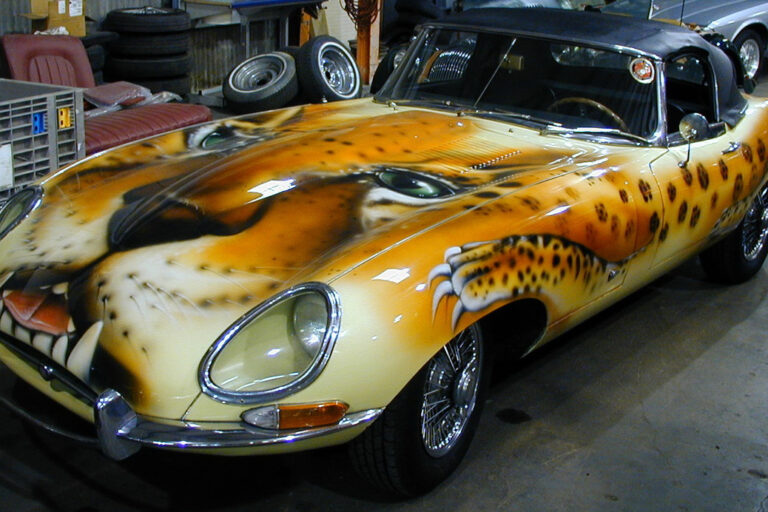
Cringe Worthy Car Trends That Have Got To Go
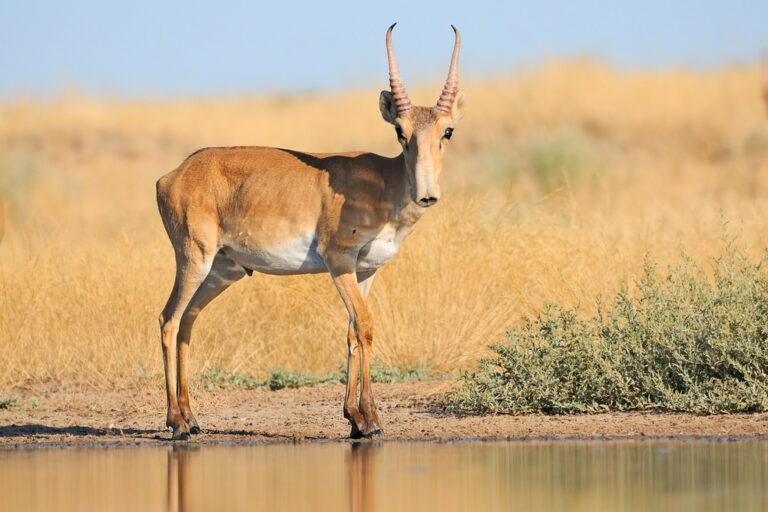
These Bizarre Animals Actually Exist

The Thomas Jefferson Mystery
